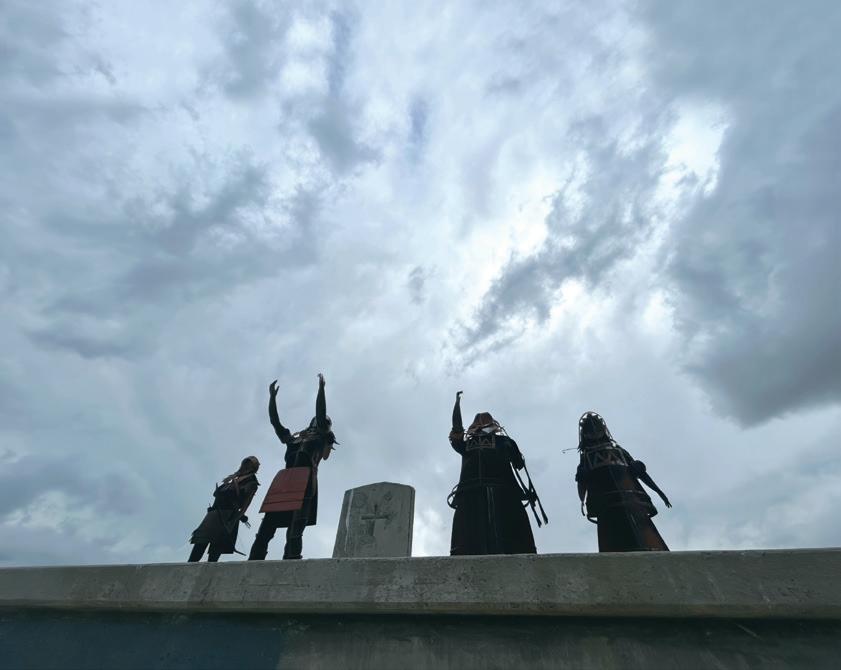
QUARTERLY VOL. 48, ISSUE 2 • JUNE 2024 US $4.99/CAN $6.99
THE
Cultural Survival PROTECT THE PROTECTORS DEFEND
DEFENDERS
JUNE 2024
VOLUME 48, ISSUE 2
BOARD OF DIRECTORS
PRESIDENT
Kaimana Barcarse (Kanaka Hawai’i)
VICE PRESIDENT
John King
TREASURER
Steven Heim
CLERK
Nicole Friederichs
Marcus Briggs-Cloud (Maskoke)
Kate R. Finn (Osage)
Laura Graham

12
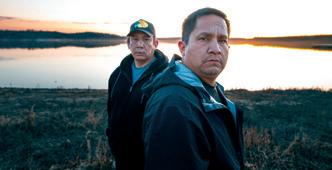
14
10 Criminalization of Indigenous Peoples Is Intensifying Globally
CS Staff
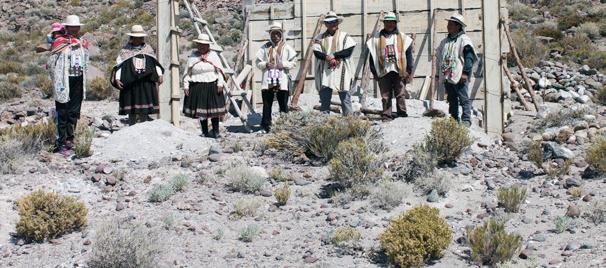
Richard A. Grounds (Yuchi/Seminole)
Stephen Marks
Mrinalini Rai (Rai)
Jannie Staffansson (Saami)
Stella Tamang (Tamang)
FOUNDERS
David & Pia Maybury-Lewis
Cultural Survival Headquarters
2067 Massachusetts Ave. Cambridge, MA 02140
t 617.441.5400 f 617.441.5417
www.cs.org
Cultural Survival Quarterly
Managing Editor: Agnes Portalewska Contributing Arts Editor: Phoebe Farris (Powhatan-Pamunkey)
Copy Editor: Jenn Goodman Designer: NonprofitDesign.com
Copyright 2024 by Cultural Survival, Inc.
Cultural Survival Quarterly (ISSN 0740-3291) is published quarterly by Cultural Survival, Inc. at PO Box 381569, Cambridge, MA 02238. Periodical postage paid at Boston, MA 02205 and additional mailing offices. Postmaster: Send address changes to Cultural Survival, PO Box 381569, Cambridge, MA 02238. Printed on recycled paper in the U.S.A. Please note that the views in this magazine are those of the authors and do not necessarily represent the views of Cultural Survival.
Writers’ Guidelines
View writers’ guidelines at our website (www.cs.org) or send a self-addressed, stamped envelope to: Cultural Survival, Writer’s Guidelines, PO Box 381569, Cambridge, MA 02238.
On the cover: A monument honoring Apache ancestors and warriors near Hell's Forty Acres on the San Carlos Apache Indian Reservation (see page 12). Photo by Brandi Morin (Cree/Iroquois).


www.cs.org
Donors like you make our work around the world possible. Thanks so much for being part of Cultural Survival!
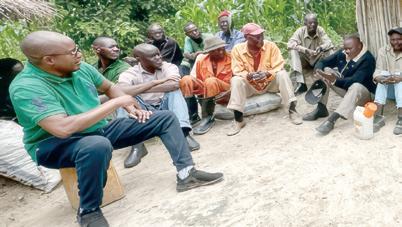
More than one-third of environmental defenders murdered are Indigenous.
12 Apache Stronghold Is Protecting a Sacred Site from a Massive Copper Mine
Brandi Morin (Cree/Iroquois)
In Arizona, the Apache Stronghold is rejecting copper mining.
14 Following the Lines Between the Mines
Bobbie Chew Bigby (Cherokee) Indigenous communities and land defenders are in the heart of South America’s Lithium Triangle.
16 “For Them, It’s Money. For Us, It’s Life”
Brandi Morin (Cree/Iroquois)
Grassy Narrows First Nation’s struggle with a 60-year legacy of poison in Ontario, Canada.
18 Strategies to Protect Indigenous Environmental Defenders
Chilekwa Mumba (Bemba)
Zambian environmental activists organized a successful lawsuit against UK-based mining company Vedanta Resources in response to pollution.
DEPARTMENTS
1 Executive Director’s Message 2 In the News 4 Indigenous Arts Rivers, Reckonings, and Reclamations
6 Indigenous Languages
Dolgan Activist Addresses Colonization of Her Peoples in Debut Novel
8 Rights in Action
Escazú Agreement: A Landmark for Environmental Rights
16
18
20 Fail Alsynov: Defender of Bashkir Land, Language, and Rights
Batani Foundation
On January 17, 2024, Fail Alsynov (Bashkir) was sentenced to four years in prison in Russia for defending Bashkir land, language, and rights.
22 We Are Under Constant Threat Rayen Rupayan (Mapuche) In Chile, Mapuche youth are addressing impacts related to transition mineral mining and the extractive industry.
23 Advocating for Indigenous Peoples’ Land Rights Through Theater
Simson Kapembe (San) San youth in Namibia are addressing the impacts of human rights violations through dramatic dialogue.
24 We Come from Within the Land
Gerard Tiwow (Minahasa) In Indonesia, Minahasa youth are protecting their lands from mineral exploitation and overdevelopment.
26 Keepers of the Earth Fund Grant Partner Spotlight
Guarani Paĩ Tavyterã Peoples
28 Staff Spotlight
Tia-Alexi Roberts (Narragansett)
29 Bazaar Artist
Arte Plumario Kozamalotl (Nahua)
ii |
www.cs.org
Page
Page
Page
Page
STAY CONNECTED
FEATURES
Defend the Defenders, Protect the Protectors
Dear Cultural Survival Community,
Halito, my name is Aimee Roberson. I am honored and humbled to serve as the Executive Director of Cultural Survival as of July 1. As a citizen of the Choctaw Nation of Oklahoma and a descendant of the Chickasaw Nation, I am passionate about upholding the sovereignty and rights of Indigenous Peoples so that we and our lifeways, cultures, languages, and the ecosystems we steward can flourish. Within my community, I am learn ing Chahta anumpa (Choc taw language), practicing traditional arts, growing and preparing traditional foods, and learning and teach ing about our history, values, and responsibilities to care for our land, waters, and plant and animal relatives.
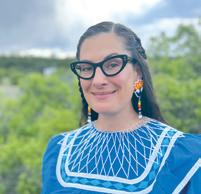
I come to Cultural Survival after serving as the Director of American Bird Conservancy’s Southwest Region. Throughout my career, I’ve worked with people across North America, stewarding ecosystems, protecting biodiversity, and planning for climate change adaptation. I have been working at the intersection of conservation and justice in support of Indigenous Peoples. As a co-founder of the Indigenous Kinship Circle, I have helped build solidarity with Indigenous Peoples and bridges with conservationists, scientists, and policymakers.
This issue of the CSQ is dedicated to uplifting the stories of a few of the many Indigenous environmental defenders who put their lives at risk to protect the planet and secure the rights of their Peoples. Indigenous defenders face a double threat: being Indigenous and defending our rights and our responsibilities to care for our environment. According to a Global Witness 2022 report, almost 40 percent of murdered environmental defenders were Indigenous, a disproportionately high figure given that Indigenous Peoples comprise roughly 6 percent of the global population. Cultural Survival’s noncomprehensive data shows 77 Indigenous defenders were murdered only in 2023 in Latin America, one of the most dangerous regions to be an Indigenous rights and environmental defender.
Three out of four assassinations of environmental defenders take place in Latin America. These figures prove systematic persecution is taking place against Indigenous defenders as a result of their opposition to mega projects, infrastructure development, mining for transition minerals, and other actions undertaken without their Free, Prior and Informed Consent. Cultural Survival is committed to working alongside Indigenous environmental defenders to ensure they can do their crucial work without repercussions and fears for their lives.
In my new role, I look forward to supporting and working with Indigenous environmental defenders and their communities alongside our staff and all of you. In these times of crises—climate change, ecocide, declining biodiversity, social inequity, and injustice—many of us are wondering how to make a difference. At Cultural Survival, we understand the interconnectedness of these crises and that Indigenous Peoples’ values, lifeways, and knowledge systems can help us envision and create a better future for us all. At the same time, colonization, extractive and unfettered capitalism, fortress conservation, and climate change continue to disproportionately harm our communities. For us to thrive as Indigenous Peoples, our inherent rights and sovereignty must be respected and our political resilience reinforced.
Will you join us in co-creating social change? Support Indigenous people in continuing to care for, defend, and protect our lands and waters. Ensure that we are engaged in decision-making and act in solidarity with us as we secure title to, reclaim, and reoccupy our ancestral and traditional homelands. Secure a future guided by the wisdom and leadership of Indigenous Peoples by supporting our ongoing work. We can’t continue without you. Please give generously at www.cs.org/ donate
Hטchi yakoke li hoke (I thank you all so much),
 Aimee Roberson (Choctaw and Chickasaw) Executive Director
Aimee Roberson (Choctaw and Chickasaw) Executive Director
CULTURAL SURVIVAL STAFF
Aimee Roberson (Choctaw & Chickasaw), Executive Director
Mark Camp, Deputy Executive Director
Avexnim Cojtí (Maya K’iche’), Director of Programs
Verónica Aguilar (Mixtec), Program Assistant, Keepers of the Earth Fund
Cliver Ccahuanihancco Arque (Quechua), Keepers of the Earth Program Assistant
Bryan Bixcul (Maya Tz’utujil), Advocacy Coordinator
Miguel Cuc Bixcul (Maya Kaqchikel), Accounting Associate
Jess Cherofsky, Advocacy Program Manager
Michelle de León, Grants Coordinator
Roberto De La Cruz Martínez (Binnizá), Information Technology Associate
Danielle DeLuca, Senior Development Manager
Georges Theodore Dougnon (Dogon), Capacity Building Program Assistant
Shaldon Ferris (Khoisan), Indigenous Radio Program Coordinator
Sofia Flynn, Accounting & Office Manager
Nati Garcia (Maya Mam), Capacity Building Manager
Byron Tenesaca Guaman (Kañari Kichwa), Fellowships Coordinator
Alison Guzman, Donor Relations Coordinator
Emma Hahn, Development Associate
Belen Iñiguez, Publications Distribution Assistant
Natalia Jones, Advocacy Associate
Mariana Kiimi (Na Ñuu Sàvi/Mixtec), Advocacy Assistant
Dev Kumar Sunuwar (Koĩts-Sunuwar), Community Media Program Coordinator
Rosy Sul González (Kaqchikel), Indigenous Rights Radio Program Manager
Marco Lara, Social and Digital Media Coordinator
Kevin Alexander Larrea, Information Technology Associate
Maya Chipana Lazzaro (Quechua), Bazaar Vendor Coordinator
Jamie Malcolm-Brown, Communications & Information Technology Manager
Candela Macarena Palacios, Executive Assistant
Cesar Gomez Moscut (Pocomam), Community Media Program Coordinator
Edson Krenak Naknanuk (Krenak), Lead on Brazil
Diana Pastor (Maya K’iche’), Media Coordinator
Guadalupe Pastrana (Nahua), Indigenous Rights Radio Producer
Agnes Portalewska, Senior Communications Manager
Tia-Alexi Roberts (Narragansett), Editorial & Communications Assistant
Elvia Rodriguez (Mixtec), Community Media Program Assistant
Mariana Rodriguez Osorio, Executive Assistant
Carlos Sopprani, Human Resources Associate
Thaís Soares Pellosi, Executive Assistant
Candyce Testa (Pequot), Bazaar Events Manager
Sócrates Vásquez (Ayuujk), Program Manager, Community Media
Miranda Vitello, Development Coordinator
Candy Williams, Human Resources Manager
Raquel Xiloj (Maya K’iche’), Community Media Grants Coordinator
Pablo Xol (Maya Qʼeqchiʼ), Design and Marketing Associate
INTERNS
Miriam Abel, Ibu Holludu, Avilinia Reyes, Diego Padilla
Cultural Survival Quarterly June 2024 | 1
EXECUTIVE DIRECTOR’S MESSAGE
Peru | Marañón River Gains Recognition as Legal Entity
MARCH
A court ruling in Nauta, Peru, has granted the Marañón River recognition as a legal entity with inherent rights. Kukama Indigenous women led the battle against environmental degradation caused by oil spills and infrastructure projects.
Brazil | Brazil Apologizes to Indigenous Peoples for Persecution During Dictatorship Era
APRIL
Brazil has formally apologized for the torture and persecution of Indigenous Peoples during its military dictatorship (1964-1985). Eneá de Stutz e Almeida, a law professor and head of the amnesty commission, kneeled before Indigenous leader Djanira Krenak (Krenak), expressing regret for the atrocities committed against the Krenak Peoples.
Ecuador | TIME honors Nemonte Nenquimo
APRIL
Nemonte Nenquimo (Waorani) received the TIME Earth Award 2024, recognizing her as a leading figure in Ecuador’s Indigenous movement against natural resource extraction on ancestral lands.
U.S. | Montana Court Invalidates Laws Disenfranchising Indigenous Voters
MARCH
In a landmark ruling, the Montana State Supreme Court struck down laws targeting Election Day registration and the restriction of paid third-party ballot assistance. The decision echoes a previous ruling in 2020 emphasizing the difficulties faced by Indigenous voters, particularly those living on reservations.
U.S. | Sacred Land Returned to Ohlone Community
MARCH
The City Council of Berkeley, CA unanimously voted to return a 2.2-acre parking lot, the last undeveloped part of a sacred
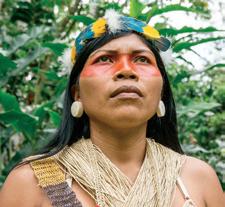
Ohlone shellmound in West Berkeley, to the Ohlone Peoples. The Sogorea Te’ Land Trust plans to create a commemorative park and cultural center to honor the area’s significance.
Canada | UN Calls Out Canada for Failure to Investigate MMIW Cases
MARCH
Canada faces accusations of breaching an international human rights treaty for neglecting to search a landfill for the remains of three Missing and Murdered Indigenous Women, disregarding a deadline issued by the United Nations Committee on the Elimination of Racial Discrimination (CERD).
Brazil | Report Finds Yanomami Exposed to Mercury
APRIL
Brazil’s top public health institute issued a report citing extensive mercury contamination from illegal gold mining that has affected the Yanomami, the Amazon’s largest Indigenous Tribe in isolation. Research conducted in remote villages along the Mucajai River revealed alarming levels of mercury in nearly 84 percent of the areas tested.
U.S. | FBI Deployed Informants to Standing Rock
MARCH
Recently revealed court documents show that during the 2016 Dakota Access pipeline protests near Standing
Rock Sioux Indian Reservation, the FBI embedded up to 10 informants within anti-pipeline camps. Details of surveillance on Indigenous environmental movements by the FBI and Bureau of Indian Affairs have been revealed, including the use of undercover agents and operatives.
U.S. | Three Native American Tribes Gain Funding for Ocean and Coasts
APRIL
Three Native American tribes in Washington, California, and Maine have been awarded $755,000 in federal funding to combat the challenges posed by climate change along coastal regions. Through projects blending Indigenous Traditional Knowledge with scientific expertise, these Nations aim to fortify ocean and coastal management while fostering climate resilience.
Canada | Ontario to Embrace Indigenous Languages in Legislative Proceedings
MARCH
Lawmakers in Ontario led a successful amendment to conduct government proceedings in Indigenous languages, marking a significant step towards acknowledging the region’s original languages. The revision allows the use of “Indigenous language spoken in Canada” when addressing the chamber or speaker, embodying the recognition of linguistic diversity and cultural heritage.
Oceania | Indigenous Leaders Grant Legal Personhood to Whales
APRIL
Indigenous leaders from Tahiti, Tonga, Aotearoa/New Zealand, and the Cook Islands have united in a treaty awarding legal personhood to whales. Led by Māori conservationist Mere Takoko and the Hinemoana Halo Ocean Initiative, the historic initiative recognizes whales (tohorā in Māori) as sacred ancestors integral to the ecosystem’s balance and the well being of Indigenous Peoples in the Pacific.
2 | www.cs.org
IN THE NEWS
In April, Nemonte Nenquimo (Waorani) received the TIME Earth Award. Photo courtesy of Amazon Frontlines.
ADVOCACY UPDATES
Latin America: Cultural Survival Reports 77 Indigenous Land Defenders Killed in Latin

Seventy-seven Indigenous defenders were known to be murdered in 2023 in Brazil, Colombia, Ecuador, Guatemala, Honduras, Mexico, Nicaragua, Paraguay, and Peru. These were people defending our planet from environmental collapse and keeping alive critical knowledge on how to protect our ecosystems. Latin America continues to be one of the most dangerous regions to be an Indigenous rights and environmental defender, as three out of four murders of environmental defenders take place in this region.
Bolivia: Communities follow up on Implementation of CERD recommendations MARCH

Cultural Survival’s Advocacy Program launches international campaigns in support of grassroots Indigenous movements as they put pressure on governments and corporations to respect, protect, and fulfill the rights of their communities.
USA: Cultural Survival Partners Receive 2024 Columbia Global Freedom of Expression Prize

APRIL
On November 22, 2023, Bolivia was reviewed by the Committee on the Elimination of Racial Discrimination (CERD). Cultural Survival and partners from the Ayllu Acre Antequera in Oruro, Bolivia, submitted an alternative report highlighting the rights violations facing Quechua communities from mining activities in their territories without their consent, which the Committee reiterated in its concluding observations. Our partners have actively followed up on these international recommendations at the national level, participating in meetings with the UN Human Rights Office in Bolivia and government officials to make sure the recommendations are properly implemented. Miners’ unions have retaliated against peaceful protests by attacking community members in Totoral Chico. Some community members have been forced to flee, and miners have blocked the entrance and egress to the community.
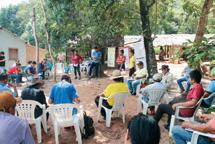
Paraguay: Paĩ Tavyterã Communities Suffer Land Invasions
The Columbia Global Freedom of Expression Prize for Excellence in Legal Services was awarded to the Human Rights and Indigenous Peoples Clinic at Suffolk University and the Association of Maya Lawyers and Notaries in Guatemala for their exceptional advocacy in the case of Maya Kaqchikel Indigenous Peoples of Sumpango et al. vs. Guatemala, in which the Inter-American Court of Human Rights declared the Republic of Guatemala “internationally responsible for the violation of the rights to freedom of expression, equality before the law and participation in cultural life” of Indigenous Peoples. The Prize specifically recognizes the work of Cultural Survival Board Member Nicole Friederichs, who is Lead Counsel and Director of the Human Rights and Indigenous Peoples Clinic at Suffolk University Law School; Amy Van-Zyl Chavarro, Of-Counsel of the Human Rights and Indigenous Peoples Clinic at Suffolk University Law School; and Cultural Survival Legal Fellows Cristian Otzin (Maya Kakchiquel) and Adriana Sunun Pablo (Maya Kakchiquel), who are Legal Advisors at the Association of Maya Lawyers and Notaries in Guatemala.
Switzerland: Indigenous-Led Summit to Examine Impacts of Energy Transition on Indigenous Peoples

APRIL
The Paĩ Tavyterã Peoples continue to suffer invasions of their land that lead to violence, forced displacement, and lack of access to justice. Three of the associations that unite the communities of the Paĩ People—Paĩ Reta Joaju, Paĩ Jopotyra, and Paĩ Rekopavẽ— met in April to discuss these problems and to prepare Rosalba Gómez to participate at the UN Permanent Forum on Indigenous Issues in April as a community representative, where, accompanied by Cultural Survival, she denounced the violations suffered by her people.
The Indigenous Peoples Global Coordinating Committee, in partnership with the Securing Indigenous Peoples Rights to a Green Economy (SIRGE) Coalition, will co-host JUST TRANSITION: Indigenous Peoples’ Perspectives, Knowledge and Lived Experiences, an international forum, on October 8-10, 2024 in Geneva, Switzerland. The goal of the summit is to challenge mainstream interpretations and implementations of the Just Transition to a green economy, which often does not represent a full transition from harmful impacts or real justice for Indigenous Peoples. The summit will affirm a rights-based approach related to any potential extractive projects proposed on Indigenous lands, with criteria and safeguards for projects and actions aligned with the Just Transition. This framework is based on the inherent collective rights articulated in the UN Declaration on the Rights of Indigenous Peoples, including the rights to self-determination, Free, Prior and Informed Consent, culture, lands, and territories, participation in decision-making, and the Paris Agreement.
Read more news at www.cs.org/latest.
Cultural Survival Quarterly March 2024 | 3
Cultural Survival Quarterly June 2024 | 3
RIVERS, RECKONINGS, AND RECLAMATIONS
L-R: Brent Stonefish and Beatrice Glow, seated, with collaborator Deborah Jack, and at the podium, collaborator Chief Vincent Mann (Turtle Clan, Ramapough Lunaape Nation), who gave the blessing for the exhibition’s opening night.


Silhouette: Beatrice Glow, Pax Hollandica, 2022. VR-sculpted photopolymer 3D print, metallic paint, enamel coating, chains. Photo courtesy of Beatrice Glow.
For her latest exhibition, “When Our Rivers Meet,” New York Historical Society artist-inresidence Beatrice Glow reckons with the 400th anniversary of the establishment of the Dutch colony of New Amsterdam upon the lands of the Lenape Peoples while also linking this to the broader colonial legacies of the Netherlands worldwide. The California-born artist’s own roots—which, on her maternal side, trace back 25 generations to Sandimen (home to Indigenous Peoples including the Paiwan and Rukai) in southern Taiwan—are themselves tied to that legacy, the island having once been the Vereenigde Oostindische Compagnie (Dutch East India Company) colony, known as Dutch Formosa. Glow’s practice prioritizes a commitment to centering and amplifying Indigenous voices through direct consultation and community collaboration while rejecting complicity with the settler colonial state. This project is just the latest in a career-spanning arc of such endeavors, which have produced not only groundbreaking research but also exquisite objects through which to contemplate the often ugly histories of empires. Cristina Verán recently spoke with Glow and one of her key collaborators, Brent Stonefish (Lunaapeew, Turtle Clan, Eelŭnaapéewi-Lahkéewiit), about this project ”When Our Rivers Meet” is on view through August 18, 2024.
Cristina Verán: Beatrice, what was the genesis of this exhibition and your collaborative approach to its creation?
Beatrice Glow: First, I wanted to envision the Dutch colonial era [of what is now New York City] from a different timeline, starting with a Lenape perspective. I wondered, what if Europeans’ relationship with Indigenous Peoples here had been one of reciprocity instead of conflict, working with the natural world instead of trying to dominate it? I knew I shouldn’t be the sole creative interpreter for this, though, and so I invited culture bearers like Brent Stonefish to contribute their deep knowledge on topics like cultural revitalization and stewardship. He and I had met back in 2016 through “Manahatta VR,” my interactive virtual reality new media project at New York University’s Asian/Pacific/ American Institute.
Brent, what made you interested in this project, and how did you approach reckoning with the histories and expectations of your community?
Brent Stonefish: For my people, having a voice in this city is crucial. This is our homeland; the histories about it have been passed down through families and what our Elders taught us. My uncle, Darryl Stonefish, has talked about how before we actually met the Dutch, we knew they were coming. Our prophecies told us of “the salty people” who would come over the salt waters. Our ancestors helped the Dutch to survive here—without them, New Amsterdam couldn’t even have happened. But in return, many Lenape were taken away, sent to the Netherlands, or even sold across the world—from the islands of the Caribbean to the Russian Empire.
One wall of the exhibition features the series of works grouped as “A Parade for All,” a response, if you will, to
INDIGENOUS ARTS
All photos by Cristina Verán.
Cristina Verán
a much earlier parade staged during the Hudson-Fulton Celebration of 1909. How did you come to know of this long-forgotten event, and what can you tell us about it?
BG: I’d found an original program for it in the New York Historical Society archives. As a kind of imperialist didactictheater extravaganza, it featured fireworks displays, a replica of explorer Henry Hudson’s ship sailing down the river, and for its main attraction, a huge parade intended as a means with which to teach new immigrants about American history through four periods: Indian, Dutch, English, and U.S. modern.
BS: The floats that were supposed to represent “Indians of North America” in it were comical—like they’d listed every Indian stereotype and just checked off each box. BG: This inspired me to think of a sort of alternative commemoration; creating our own floats that would respond to those in that original parade.
Your collaborative piece, “Sigillum Manahahtáanung” (Law of the Place Where We Gather Hickory Wood to Make Bows), features a reimagined official seal of New York. What specific elements of the original did you feel needed revising?
BS: We wanted to turn it upside down, and so for one thing, we replaced the male figures (a Dutch merchant and a Lenape man holding a bow and arrow) with female ones, emphasizing matrilineal societies. We also added the tree of life to it; things that should have been there in the first place. BG: The city now sits on top of a turtle, being supported by a bow and arrow.
BS: Manhattan is like a baby turtle; separate from the rest of Turtle Island but right by its side, like one of its babies.
What other elements did you find important to include?
BG: There is a beaver, an animal that was so important to, and exploited by, the Dutch West India Company. When you look at paintings by the Dutch artist Vermeer, which often show people with fancy fur hats, that’s actually beaver fur from Lenapehoking (Lenape homelands). And also there are quahog shells, where wampum comes from. These were extracted by the colonists to build many of the early limestone buildings of this city.
BS: We, as Lenape, make wampum shells into beads, and use them in a lot of different things, both spiritual and everyday material objects. In our culture, their colors, purple and white, have deep significance. For example, if the majority of a wampum belt is purple, that speaks about a dark time. But if it is white, then it talks about peacetime.
Beatrice, you regularly incorporate new technologies in the development and production of your art. Take us through that process here.
BG: For each piece, I began by working out several versions in VR sculpting, which allows me, while wearing a goggle headset and using two controllers, to play with “digital clay”
I can virtually mold, sand, and paint with digital tools. I can make the virtual object really large to play with its scale and detail with a lot of care. For example, when creating a face, I can represent its features with great accuracy. From this, I create a 3-D model that can then be printed into a physical object or brought into video work, such as this exhibition’s virtual reality reconstruction of a book that comes to life as the viewer becomes a bird flying through Manhattan, traveling through time.
“When Our Rivers Meet” includes additional collaborators as well; both Indigenous to this region and from faraway lands once also subject to the Dutch colonial enterprise. Why was this important for you?
BG: I’m concerned with how we can reckon with colonial violence, not only here, but around the world through survivance and building new kinships, solidarities, and alliances. My other collaborators include Chief Vincent Mann and Michaeline Picaro Mann (Ramapough Lunaape) for the piece called “We Are Still Here.” Tecumseh Caesar (Matinecock and Unkechaug) and made “Revolutions to Love Our More-Than-HumanRelatives,” a carousel that questions the ways in which animals and women have been treated by the Europeanimposed order. “Gilded Embers, Salted Entanglements,” the piece made with Deborah Jack, of St. Maarten heritage, is about salt extraction in the Dutch Caribbean, and “All Islands Connect Underwater,” was created with Netherlands-based Wim Manuhutu and Nancy Jouwe, whose families trace back to Maluku and West Papua in the former Dutch East Indies (now Indonesia). Also, Afro-Indigenous genealogist Teresa Vega contributed “Riding with My Ancestors While We Spill the Tea,” and then "From Ports to Ports" by SurinameseDutch artist Raul Balau is a kind of portal between New York and Amsterdam.
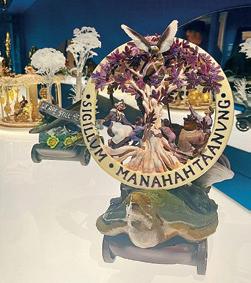
I also want to acknowledge Rebecca Klassen, Curator of Material Culture at the New York Historical Society, for being very interested in including contemporary artists with diverse perspectives to broaden the interpretation of their massive and remarkable collection.
Cristina Verán is an international Indigenous Peoplesfocused researcher, educator, strategist, curator, and media-maker. As adjunct faculty at New York University Tisch School of Arts, she brings emphasis to Indigenous popular music, visual and performing arts, and sociopolitical movements.
Cultural Survival Quarterly June 2024 | 5
The main piece
Beatrice Glow and Brent Stonefish produced together.
DOLGAN ACTIVIST ADDRESSES COLONIZATION OF HER PEOPLES IN DEBUT NOVEL
Kseniia Bolshakova (Dolgan) is an Indigenous language activist and writer and a member of the Dolgan Tribal community Yydyna (“Moonlight” in Dolgan), born and raised in the Dolgan settlement and tundra of Popigai on the Taymyr peninsula in the Russian Arctic. She grew up reindeer herding, fishing, hunting, and gathering. Bolshakova is deeply concerned about the loss of her mother tongue and Traditional Knowledge, as well as issues of ongoing colonization and the results of assimilation by the Russian State. “I am very worried about the low self-determination in my community. Because of this, my people are largely indifferent to the loss of our native language, Traditional Knowledge, and way of life. I understand that this is due to colonization and not being recognized by the authorities as Indigenous Peoples themselves, as well as State assimilation efforts succeeding. Being small in number, we are in danger of extinction, both physically and spiritually,” she says.
Dolgan is the northernmost Turkic language in the world and is closely tied to reindeer herding. There are only 8,000

Dolgans and just 800 speakers of Dolgan worldwide, making Dolgan a critically endangered language. Bolshakova belongs to the youngest, and possibly last, generation of Dolgan speakers. The closest linguistic relative to Dolgan, which means “tribe living on the middle reaches of the river,” is Sakha. The language is local and restricted to a small area, and has declined in usage due to assimilation efforts by the Russian State.
Bolshakova is one of two people in the world to write prose in Dolgan. She is passionate about Indigenous languages and currently works as a content manager of the Sakha (Yakut) language learning application, Sakhalyy, and as an editor of the lexical database and electronic dictionary of the Chukchi language. She is also a linguistic data coding assistant on the Kumandy language at Dartmouth College. Bolshakova crafts her prose in the dynamic and concise genre of flash fiction. Her debut bilingual Dolgan and Russian-language flash novel, “The Frost Also Melts,” is composed of 16 flash novellas. A flash novel is a relatively new literary form that combines the brevity of flash fiction with the narrative depth of a traditional novel. It consists of a series of interconnected vignettes, allowing for a nonlinear narrative structure. Bolshakova’s narratives encapsulate memories from her nomadic childhood in the tundra and reflections on the destiny of the Dolgans. The novel is about the forever that is becoming finite: permafrost, tundra, reindeer herding, and native language.
The production of Bolshakova’s book was supported by Cultural Survival’s Indigenous Youth Fellowship program, which supports young Indigenous leaders between the ages of 17-28 who are eager to learn about technology, program development, journalism, community radio, media, and Indigenous Peoples’ rights advocacy. Since 2018, the program has awarded 110 fellowships supporting 204 fellows. Fellowships allow youth to build capacities in Indigenous rights, Indigenous languages, cultures, and Traditional Knowledge, assisting them in representing the voices of their communities and raising awareness of local issues in global conversations while strengthening their cultural identities and leadership skills.
Bolshakova’s fellowship project, “Haka Huruk: Transmitting Dolgan Values by Creating Dolgan Literature,” focuses on revitalizing the Dolgan language through storytelling and the development of bilingual literature in Dolgan and Russian. The following is the first chapter of “The Frost Also Melts,” titled “The Forever and the Finite.” To read more, find her on Instagram at @haka.huruksut.
6 | www.cs.org INDIGENOUS LANGUAGES
Kseniia Bolshakova
THE FOREVER AND THE FINITE
Kseniia Bolshakova (DOLGAN)
The North is usually associated with heroic Soviet films about polar explorers and oil men on their long lucrative tours of duty. Some people were born in Siberia because their great-grandfathers and grandfathers came here with their great and small communist construction projects. Some people’s families were persecuted and exiled to our lands, so savage and unfit for life. And some people call themselves native Siberians because 300 years ago their ancestors came here with swords and fire to conquer our lands for the expansion of Muscovy. Among these millions of northerners, the original Indigenous Peoples of the North become statistically utterly insignificant.
The “Extreme North” is a flexible concept. It contains both the desert sands on the Mongolian border and my native Taimyr, a desert of snow washed by the icy Arctic Ocean. The most arctic of Arctics, the permafrost zone. The imperial, Soviet, and modern-day Russian authorities always considered the North an inexhaustible borehole. Taimyr really does mean countless oil deposits, natural gas, platinum, gold, silver, nickel. But nothing is infinite and forever. Global warming is rapidly melting the permafrost. The mining companies will eventually exhaust our assets—our depths. And the Indigenous Peoples are flickering out, cut off from traditional lifeways, mired in assimilation and left in a civilizational breach with no provisions.
The times when the Indigenous peoples of Taimyr lived in chooms have passed. Now reindeer herders move around in baloks. A balok is a portable home on sledge runners. On the outside the wooden framing is covered in felt and reindeer skins with a tarp over top. My family are lower Dolgans, who live by the lower reaches of the river Khatanga. My grandmother remembers that the upper Dolgans were the first to start moving from chooms to baloks. The lower Dolgans started using a winter balok only in the 1980s, and a summer one only in the 1990s. Living further to the north, we kept our language and our reindeer herding longer than the upper Dolgans. But now even among the lower Dolgans there are basically no kids who speak Dolgan anymore and no reindeer families either.
Now all of our relatives live a settled life in the rural settlement of Popigai and the village of Khatanga. My mother’s parents, grandpa Alyosha and grandma Masha, spent their whole lives in the tundra. My grandfather was the foreman of the first reindeer herding brigade
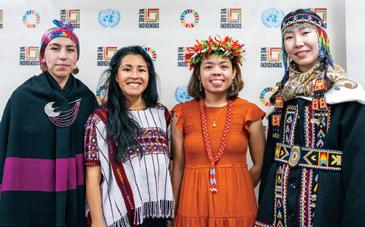
in his home settlement of Old Popigai. The Popigai herd was the biggest in the Khatanga district. Grandfather was very respected throughout the district both among the nomads and the village people. He often got written about in the newspaper and was even awarded the title “Honorable Citizen of Taimyr.” Grandmother was born in the now-closed rural settlement of Novoletovye to the north of Zhdanikha. She went to veterinary school in Dudinka, and after her studies the Khantanga veterinary station sent her to work in the Popigai tundra. In this way, grandmother and grandfather’s working life in the tundra went on year after year. They raised five daughters who gave them 10 grandchildren. I was their first granddaughter.

Their last nomadic years were also the years of my childhood. I was unspeakably lucky to have experienced both the reindeer games of childhood and grown-up reindeer herding concerns by their side. The tundra went deep into my heart. It was the tundra that nurtured in me a sense of unity with our spirits, our people and our land. This power is my Dolgan staff that helps me make my way through life, supports me, and keeps me from going to pieces.
English translation by Ainsley E. Morse.
Cultural Survival Quarterly June 2024 | 7
Kseniia Bolshakova (far right) with CS Youth Fellow, Rayen Rupayan (Mapuche); CS Capacity Building Manager, Nati Garcia (Maya Mam); and CS Youth Fellow, Shaylin Salas (CHamoru). Photo by Jamie Malcolm-Brown/Cultural Survival.
ESCAZÚ AGREEMENT A Landmark for Environmental Rights
 CS Staff
CS Staff
The Escazú Agreement, officially titled the Regional Agreement on Access to Information, Public Participation, and Justice in Environmental Matters in Latin America and the Caribbean, is a historic milestone in regional environmental governance. Adopted on March 4, 2018 after four years of negotiations, it represents the first binding regional environmental treaty. Named after the city in Costa Rica where it was finalized, the agreement can potentially advance environmental protection and human rights across the region.
The Escazú Agreement’s progress has been marked by both successes and challenges. To date, 15 countries have ratified the treaty. At the heart of the Escazú Agreement are principles deeply rooted in international environmental law, particularly Principle 10 of the 1992 Rio Declaration on Environment and Development, which underscores the importance of public participation and access to information and justice in environmental decision-making processes. Building upon this foundation, the Escazú Agreement seeks to empower individuals and communities to actively engage in environmental governance, thereby fostering transparency, accountability, and sustainability.
A significant aspect of the Escazú Agreement is its explicit recognition of the critical role played by environmental defenders. This is especially important in Latin
America, which is one of the most dangerous regions to be an Indigenous rights and environmental defender; three out of four assassinations of environmental defenders occur there. This dire situation underscores the urgent need for protections for defenders. By requiring member States to recognize, protect, and promote the rights of environmental defenders, the agreement sends a powerful message about the importance of safeguarding human rights in the context of environmental activism. The agreement holds particular significance for Indigenous Peoples, who have been stewarding biodiversity for millennia. It includes provisions to ensure Indigenous Peoples’ meaningful participation in environmental decision-making processes and grant them access to environmental information and justice.
A significant concern regarding the treaty is the lack of explicit requirements for Free, Prior and Informed Consent (FPIC) for Indigenous Peoples. While the agreement promotes public participation in decision-making processes, it fails to guarantee Indigenous Peoples’ rights to FPIC, as outlined in the UN Declaration on the Rights of Indigenous Peoples and the International Labour Organization Convention 169. Implementation of the Escazú Agreement has also proven uneven across signatory countries. While some have made notable strides in incorporating its principles into national legislation and policies, others have been less successful in translating its provisions into tangible actions. In particular, civil society organizations have raised concerns about limited access to environmental information and meaningful participation in decisionmaking processes, particularly for marginalized communities such as Indigenous Peoples.
To address these challenges and advance the objectives of the Escazú Agreement, ongoing efforts are needed at both the national and regional levels. This includes strengthening institutional capacities, enhancing public awareness and education about environmental rights, and fostering greater collaboration between governments, civil society, and Indigenous Peoples. Additionally, greater accountability and transparency in implementing the agreement, including mechanisms for monitoring and reporting on progress and addressing environmental rights violations, are needed.
Articles 5, 6, 7 and 8
Article 5 establishes the importance of facilitating access to environmental information and mandates member States to ensure transparency in disseminating such information. It mandates States to assist Indigenous Peoples in
8 | www.cs.org
INDIGENOUS LANGUAGES
Indigenous and civil society representatives during a side event at COP2.
navigating information requests. Article 6 outlines the principles governing public participation in environmental decision-making processes, emphasizing inclusivity of Indigenous Peoples. Article 7 recognizes public participation in environmental decision-making processes and stresses early involvement of the public, including Indigenous Peoples, in decision-making about environmental permits, land use planning, and policy formulation, underscoring traditional methods of participation, and diverse cultural contexts. Article 8 sets the standard of access to justice in environmental matters and affirms the right to seek legal recourse when access to environmental information is denied, participation in decision-making is restricted, or projects pose environmental risks.
Most significant achievements
Every year, the parties to the agreement meet at the Conference of the Parties (COP) to assess progress. Some of the most important recent decisions include:
COP1 (April 20-22, 2022, Santiago de Chile):
• Establishment of rules for the election of the Committee to Support Implementation and Compliance, a key body to promote agreement implementation.
• Establishment of an ad hoc working group on human rights defenders in environmental matters highlights a commitment to protecting environmental activists.
• Inauguration of the annual forum on Human Rights Defenders in Environmental Matters in Latin America and the Caribbean, which fosters dialogue and collaboration on environmental protection.
COP2 (April 19-21, 2023, Buenos Aires, Argentina):
• Election of the seven members of the Committee to Support Implementation and Compliance from Argentina, Chile, Uruguay, Grenada, Costa Rica, Jamaica, and Panama, ensuring diverse representation.
• Continued work of the ad hoc working group on human rights defenders, resulting in the development of an Action Plan on Human Rights Defenders in Environmental Matters.
• Presentation of the draft annotated index of the Action Plan, marking progress towards concrete measures for protecting environmental defenders.
COP3 (April 22-24, 2024, Santiago de Chile)
• Approval of an Action Plan on human rights defenders in Latin America and the Caribbean.
• Ecuador, Argentina, Santa Lucia, Belize, Mexico, Uruguay, and Chile shared their national plans for implementing the treaty.
• Inclusion of public participation, including Indigenous Peoples, in the development of plans and roadmaps for the implementation of the agreement at national levels.
OTHER MECHANISMS TO PROTECT ENVIRONMENTAL DEFENDERS
UN Special Rapporteur on Environmental Defenders
The establishment of the UN Special Rapporteur on Environmental Defenders in 2022, with Michel Forst as its inaugural appointee, marks a historic milestone in international human rights advocacy. Central to the Special Rapporteur’s mission is addressing the alarming trend of environmental defenders being targeted, particularly in contexts where foreign companies seek to exploit natural resources on their territories. Defenders can initiate contact by submitting complaints via email, utilizing a prescribed format on the rapporteur’s website. Upon receipt, the rapporteur’s team engages with the defender to assess the credibility of threats and allegations. Should evidence corroborate the claims, the rapporteur promptly issues inquiries to the relevant State or company, allowing 60 days for response. The rapporteur has the authority to conduct country visits without requiring a State invitation, enabling swift investigation of urgent cases. In cases of extreme urgency, the rapporteur can issue immediate measures, such as relocation of defenders abroad, to ensure their safety. Learn more: tinyurl.com/unspre
Kunming-Montreal Global Biodiversity Framework
The Kunming-Montreal Global Biodiversity Framework, adopted at the 15th Conference of the Parties to the UN Convention on Biological Diversity (CBD COP15) in 2022, sets forth critical targets and principles for global biodiversity conservation. Target 22 emphasizes inclusive decision-making advocating for the respectful acknowledgment of Indigenous Peoples’ cultures and rights over their lands, territories, resources, and Traditional Knowledge, while spotlighting the protection of environmental human rights defenders. This recognition underscores the urgent need for nations to enact comprehensive laws and policies to shield these defenders from threats, violence, and persecution. Implementation of Target 22 requires countries to integrate measures for protecting environmental defenders into their National Biodiversity Strategies and Action Plans (NBSAPs). Nations must report on the number of environmental defenders killed, providing crucial data to assess the gravity of threats. Learn more: tinyurl.com/cbdkmgbf.
Regional Human Rights Bodies
Regional human rights bodies, such as the Inter-American Commission on Human Rights (IACHR) and the African Commission on Human and Peoples’ Rights (ACHPR), play crucial roles in addressing human rights violations, including those faced by environmental defenders, within their respective jurisdictions. These bodies may issue reports, recommendations, and decisions that highlight cases of attacks against environmental defenders and call for accountability.
Corporate Accountability Mechanisms
Some mechanisms focus on holding corporations accountable for human rights and environmental abuses, including those targeting defenders. The Organisation for Economic Co-operation and Development (OECD) Guidelines for Multinational Enterprises provide a framework for responsible business conduct, including respect for human rights and environmental standards. Additionally, mechanisms such as the UN Guiding Principles on Business and Human Rights and the Corporate Human Rights Benchmark assess and promote corporate respect for human rights, including the rights of environmental defenders.
Cultural Survival Quarterly June 2024 | 9
CRIMINALIZATION OF INDIGENOUS PEOPLES IS INTENSIFYING GLOBALLY

Cristina Coc (Maya Q’eqchi), Advocacy Coordinator at Indigenous Peoples Rights International (IPRI) moderating panel "Criminalization of Indigenous Peoples’ Rights" organized by IPRI in the Indigenous Media Zone at the UNPFII in April 2024, with Victoria Tauli-Corpuz (Kankanaey Igorot) and Fergus McKay.
by Jamie MalcolmBrown/Cultural Survival.
CS Staff
Around the world, Indigenous Peoples face an increased and widespread criminalization in exercising their rights, including when protesting against the very violations of their rights. According to Global Witness, in 2022, 177 people were murdered for defending human rights, their lands, and our environment. More than one-third, 36 percent, of the defenders murdered were Indigenous, despite Indigenous people making up only 6.2 percent of the world’s population. Latin America is one of the most dangerous regions to be an Indigenous rights and environmental defender. Three out of four assassinations of environmental defenders take place in Latin America. In 2023, Cultural Survival tracked 77 murders of Indigenous defenders in Latin America, up from 52 in 2022, and 33 in 2021.
“Indigenous Peoples are the protectors of nature, biodiversity, lands and cultural heritage. However, even as they defend these territories, we see that the criminalization of Indigenous Peoples is intensifying,” Cristina Coc (Maya Q’eqchi), Advocacy Coordinator at Indigenous Peoples Rights International (IPRI) said at a panel organized by IPRI in the Indigenous Media Zone at the 23rd Session of the UN Permanent Forum on Indigenous Issues in April 2024. Based in the Philippines and established in 2019 to lead and coordinate the Global Initiative to Address and Prevent Criminalization, Violence, and Impunity against Indigenous Peoples, IPRI works to protect Indigenous Peoples’ rights and to unite and amplify the call for justice for victims of criminalization and impunity. Victoria Tauli-Corpuz (Kankanaey Igorot) from the Philippines, Director of Tebbteba,
Co-founder of IPRI, and former UN Special Rapporteur on the Rights of Indigenous Peoples and Fergus McKay, Senior Legal Counsel at IPRI spoke at the panel.
In February 2024, the UN Permanent Forum on Indigenous Issues presented their most recent report, “Criminalization of Indigenous Peoples’ Human Rights,” which focuses on the typology and examples of criminalization, relevant international instruments, jurisprudence and access to justice, and conclusions and recommendations. It provides recommendations for UN bodies, governments, and others to better address this growing threat. We present excerpts of comments of the panelists about the report and the issue of criminalization here.
Victoria Tauli-Corpuz (Kankanaey Igorot)
“I have been receiving consistent complaints from Indigenous people from all over the world about the fact that they are being criminalized. False accusations are filed against them, and several of them have been detained in the courts. It’s a very serious concern because Indigenous people have been resisting displacement from their lands and territories and also protecting their resources. They are the ones who most commonly face charges of criminalization. They are accused of [being] anti-development. Even while I was the UN Special Rapporteur on the Rights of Indigenous Peoples, I was included in a list of 300 so-called terrorists in the Philippines.
This report has been the precursor for me to propose that we create Indigenous Peoples Rights International, because I believe that focus should be given to the issue of criminalization. This is what brings fear to Indigenous communities, and it’s also what curtails their capacities to assert their right to self-determination and to be critical of States
10 | www.cs.org
Photo
and corporations who are violating their rights. It’s also communities that are criminalized and put into prison
My official visit to Australia showed that while Australian Aboriginal people are 5 percent of the population, they occupy 50 percent of the jails of Australia. This speaks about the racism and discrimination that exist, which is the foundation for filing all these criminalization cases against them.
[What] is important is the empowerment of the Indigenous Peoples themselves, the individuals, as well as the communities. If they are empowered to know more about their rights and to assert and claim these rights, the chances of them being able to get charges dismissed are bigger. Secondly, I think that resources should be made available for them so that they can avail of the services of pro bono lawyers. Many Indigenous leaders are in jail for a long time because there are no lawyers that will take up their case. There’s really a need to make available the services of lawyers and the resources needed for them [in] the domestic courts, but also to make use of the special procedures to make a report to the rapporteur. The role that the mandate-holders can play is also important. [For example], the World Bank continues to fund a project in Tanzania to expand protected areas, which has caused the displacement of Maasai Peoples. Because a complaint was made to the World Bank, the inspection panel is in the process of studying [it]. Documenting and helping the people to document themselves is the first step. These reports that talk about criminalization are going to be crucial also in exposing the issue and getting various multilateral bodies and countries to speak against what’s happening.”
Fergus McKay, Senior Legal Counsel at IPRI
“The bulk of criminalization is deeply embedded in national legal frameworks, and it’s usually connected to inadequate recognition or non-recognition of Indigenous Peoples’ rights in those frameworks. National law doesn’t recognize that Indigenous Peoples have rights to land or only partially recognizes it in a fragmented way that [denies] full ownership or full jurisdiction over those lands. Areas that are not included become available to third parties for protected areas, climate mitigation projects, and various other things. We’re seeing that Indigenous Peoples are not only being denied the exercise of their rights, but they’re actually being criminalized for continued occupation and use of these areas—occupation and use that they have a right to do under international human rights law. The root of the problem is national law that doesn’t properly recognize Indigenous Peoples’ rights, more so than using criminal law to suppress protest or to punish people for defending their rights.
One very important decision from 2021 was the case Indigenous Maya Kaqchikel Peoples of Sumpango vs. Guatemala, which involved the criminalization of community radio stations. The Inter-American Court of Human Rights found violations of the right to culture and the right
to freedom of expression in conjunction with self-determination in the case of Indigenous Peoples. It also found that the criminalization of those activities aggravated those rights violations and constituted a whole new level of violations. The court…required that all of those convictions be overturned and any sentences and any penalties expunged; to put it back to as if the criminalization had never occurred in the first place. That’s what should be happening with the bulk of these cases. We have people in one country in jail for up to 12 years for killing buffalo in their cultural ceremonies. There are literally thousands of Indigenous people in jail in that country for consuming buffalo because the dominant religion doesn’t agree with it, whereas it’s part of the practice of their cultural traditions, their spiritual practices, and various other rights.
There’s a need to deep dive into national laws to identify where rights are being criminalized and where those laws need to be reformed. The Committee Against Torture under the Convention Against Torture has the ideal mechanism for doing that. One of its articles requires continuous review of national laws to deal with issues under the heading of torture and cruel and inhumane treatment, and they have explicitly defined imprisoning Indigenous Peoples as a form of cruel and inhumane treatment. The 50 percent [incarceration] rate in Australia is common in many countries around the world. There are very clear avenues for saying we can go through national laws and address where there are criminal sanctions being unjustifiably applied to the exercise of rights, or in the context of these disproportionate, racially discriminatory practices, which should be illegal constitutionally as well as under human rights law. There was a case against Mexico recently decided by the Committee Against Torture where they explicitly stated in their recommendations that Mexico should cease the criminalization of the defense of Indigenous Peoples’ Rights. But it was one sentence in one case. We need more of that. We need it more mainstreamed, and we need it attached to funding conditionalities, [because] it’s going to get worse. Fifty percent of transition minerals are on Indigenous lands. In some countries, it’s 80 to 90 percent. Protected areas are about to be doubled.”
Cristina Coc (Maya Q’eqchi), Advocacy Coordinator at Indigenous Peoples Rights
“It’s very important to look at criminalization in its entire spectrum. One of the things that is really important to highlight is that the individual crimes and violations of human rights against Indigenous individuals are not distinct and separate from the assault and violations against entire communities, because we are part of collective communities. When you violate an individual’s right, the impact is not just on that individual; it impacts the entire community. Land defenders, as human rights defenders, are the ones that are protecting nature, that are protecting life. They are the ones that are under immense threat.”
Cultural Survival Quarterly June 2024 | 11
APACHE STRONGHOLD IS PROTECTING A SACRED SITE from a Massive Copper Mine
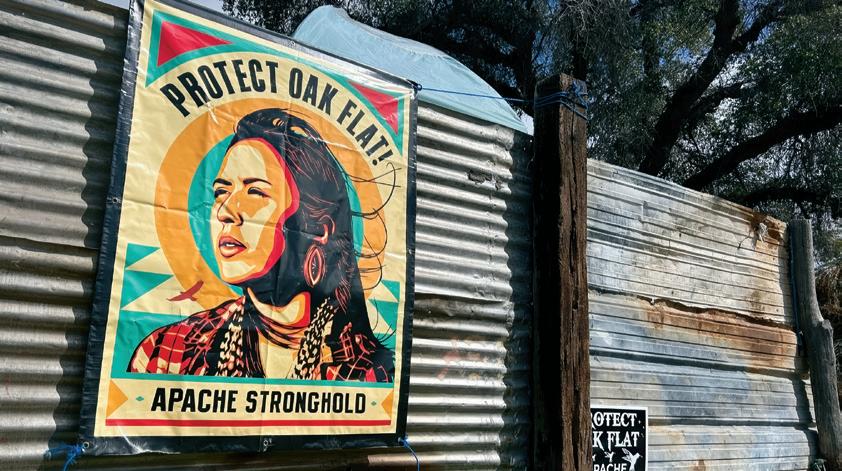
Brandi Morin (CREE/IROQUOIS)
Bulletproof
In the heart of the Arizona high desert lies a battle for the soul of the land. The sacred grounds of Apache Native territory are under threat from a massive copper mine in the pathway to the so-called green transition. But, as is often the case, it comes at a cost. The San Carlos Apache Tribe calls it Chi’chil Bildagoteel; English speakers call it Oak Flat. It sits on a mountainous plateau within a 17.3-kilometer oasis in the Tonto National Forest.
Rio Tinto and BHP, two of the world’s biggest mining companies, have staked their claim here through a joint venture called Resolution Copper. For over 10 years, they’ve been lobbying governments to build a colossal mine covering roughly 7,000 acres of surface area and extending more than a mile into the ground. The only thing that stands in their way is the resistance of the Apache Stronghold, a community organization of Natives and non-Natives uniting to counter ongoing colonization, defend holy sites, and protect freedom of religion.
The Apache have revered the life-giving medicine that thrives here through various species of plants, animals, and Emory oak trees. Some oak trees are over 1,000 years old and provide the Apache’s most coveted ceremonial item and food source: acorn flour. The Tribe, whose holy people have always lived nearby, believes the natural springs flowing beneath Chi’chil Bildagoteel provide healing powers that can only be found here. “Understand we’re sitting in a holy place, in a sacred place,” says Dr. Wendsler Nosie Sr., an Apache Elder and community leader. “Our ceremony,

called Na’i, is a repeat of how creation was created and how the angels brought us to the surface to see God’s work and to live in the moment. These are real critical places for us.” Nosie has been living at Chi’chil Bildagoteel for over two years to protect it from the proposed mine, leading the Apache Stronghold.
Resolution Copper is owned by two foreign entities, Rio Tinto (which has an atrocious track record for violating Indigenous rights, having blasted away an ancient Indigenous holy site in Australia in 2020) and BHP, the world’s biggest mining company. BHP also has a dark history of forcible displacement of Indigenous and Afro-descendant communities, as well as catastrophic environmental damage. The mine is projected to use 250 billion gallons of water over 40 years to process ore in a drought-stricken area. It will also use the water to help store toxic tailings in ponds stretching for miles. The company’s rhetoric argues that America needs copper, and it is accepted policy that meeting climate goals for vehicle electrification requires an urgent ramp-up in copper production despite harmful impacts to land, water, and communities. The International Energy Agency reports that production needs to triple by 2040.
The Apache Stronghold has been waging its fight in the U.S. Circuit Court of Appeals. In late April, the court rejected
12 | www.cs.org All photos by Brandi Morin.
Chi’chil Bildagoteel resistance camp featuring a colorful poster of Naelyn Pike.
Inset:
vest worn by Dr. Wendsler Nosie Sr. Noise has been shot at four times.
an appeal of a lower court’s ruling from 2021 that found the mine wouldn’t threaten the Apache’s First Amendment religious practice rights. Now, they are taking the case to the U.S. Supreme Court.
Chi’chil Bildagoteel was once protected. In 1955, President Eisenhower listed the area on the National Register of Historic Places as a Traditional Cultural Property. That designation stood until 2014, when Senator John McCain slipped a rider onto a National Defense Authorization Act to allow the sale of Oak Flat to Resolution Copper.
The area holds more than just ceremonial significance. During the expansive wars between the Apache, the U.S., and Mexico, it was part of the San Carlos reservation and served as a prisoner of war camp. Nearby is Apache Leap, where Apache warriors jumped over a cliff to their deaths rather than surrender to the U.S. Cavalry in 1870. The remaining prisoners of war were rounded up and taken to a valley in the San Carlos reservation, where they were imprisoned and ultimately killed. The Apache now refer to it as Hell’s Forty Acres. “We once roamed all the mountains, and we lived in bands and communities and family,” explains Dr. Lian Bighorse of the San Carlos Apache Tribe Wellness Program and Nosie’s daughter. “And now we’re imprisoned on a reservation . . . but that’s the land we were put on.” Until the 1960s, Apaches from San Carlos weren’t allowed to leave the reservation without the permission of the Indian Agent.
Local Apache clans still pray at the same mountain nearby where famed Apache warrior Geronimo requested to pray before U.S. Cavalry soldiers hauled him away to Florida in chains. These lands hold the memories of their forefathers, like Geronimo, Cochise, Victorio, and Mangus Coloradas, and their fight to save their territories from invaders. That cycle is repeating itself. “When you don’t have a connection to the land, when you don’t know the history of the people, is when that doesn’t matter to you...when all you see is how you can profit off of things, when it’s that money and power and greed—it’s an illusion. If you call America your home, how can you just destroy it that way?” Bighorse implores.
Multiple generations of the Nosie family have been at the forefront of protecting Chi’chil Bildagoteel. Nosie’s granddaughter, 27-year-old Naelyn Pike, has traveled with him across the United States to speak out against the mine. “This is no longer a game of bows and arrows and shooting us physically. It’s killing our religion, our way of life, and who we are as a people,” says Pike. “That scares me . . . that the federal government can still do this to our people today.” Pike had her coming of age ceremony at another Apache holy site, Mount Graham, which Nosie has been working for decades to protect from the expansion of a massive observatory. “I was able to wake up that mountain. That was a very powerful moment for me, because as Apache people, we’re stewards of the land. When I had my ceremony there, I definitely felt the power of my ancestors. I felt the power of the mountain and the animals...I got to experience [that] because of that fight of my people,” Pike says.
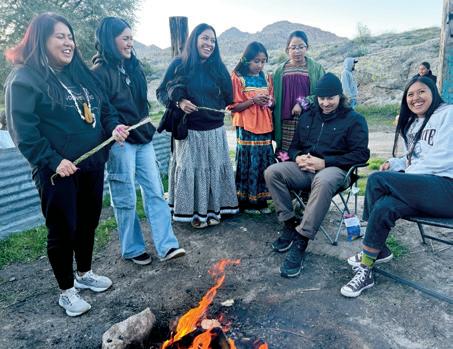
Reclaiming their ancestral lands, and protecting them from invaders, is dangerous. Since Nosie has lived out here he’s been shot at four times. But Nosie doesn’t do battle with modern day weaponry. He gains his strength through ceremony and prayer, regularly walking the desert terrain and visiting sacred corridors to conduct ceremonies. Nosie’s daughter, Vanessa Nosie, who is also Pike’s mother, visits Nosie as often as she can. She cherishes Chi’Chil Bildagoteel and helps in the fight to protect it. “This is a place where all our teachings come from. This is where I can be a mom and teach my children, my daughters, what it is to be an Apache woman and to carry on the legacy of our people and our family,” she says.
Still, Nosie’s children are concerned for his safety. “We’re facing the two biggest mining giants in the world; they have the potential to get rid of him. Pike believes her grandfather is a target because the mining company has made him out to be a troublemaker,” Vanessa says. Bighorse says the priorities of those targeting her father are backwards: “He’s hated, just because he protects the land.”
Rio Tinto claims that it conducted extensive consultation with local Tribes and that it is heavily invested in the future of the residents in the area. While the destiny of this holy place now lies with the Apache Stronghold’s upcoming court case, Nosie says he’ll never leave. “When the U.S. comes out with their most critical list of important [resources], you find copper, gold, silver... but you don’t find water and air. It confuses us because as Indian people, those are the main two sources that you have to protect. It’s why I left the reservation two and a half years ago to move back. So, if they want to remove me, they’re going to have to remove me forcefully.”
Brandi Morin (Cree/Iroquois/French) is an award-winning journalist reporting on human rights issues from an Indigenous perspective. Access the full story and video: tinyurl.com/apachestrong
Cultural Survival Quarterly June 2024 | 13
Dr. Nosie Sr.'s daughter, grandchildren, and other relatives gather at Chi'chil Bildagoteel.
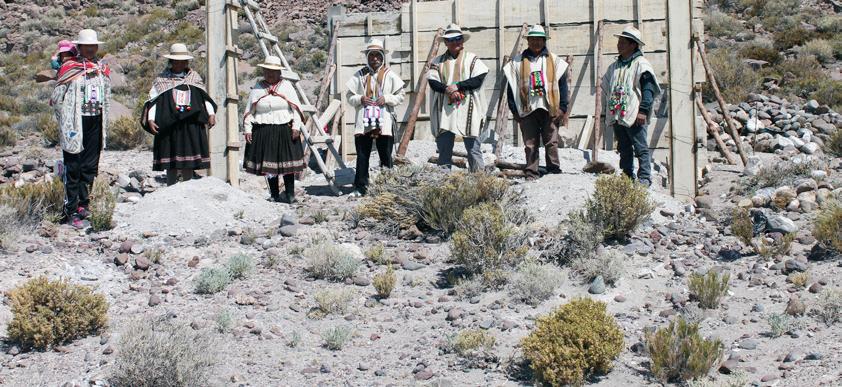
FOLLOWING THE LINES BETWEEN THE MINES
INDIGENOUS COMMUNITIES AND LAND DEFENDERS IN THE HEART OF SOUTH AMERICA’S LITHIUM TRIANGLE
Bobbie Chew Bigby (CHEROKEE)
In 2003, thanks to a summer scholarship provided by the American Field Service, I was sent during my second year of high school to Bolivia. One of the key field trips that summer was to the city of Potosí, a city that sits at one of the highest elevations in the world— and more specifically, the city’s famed Cerro Rico mountain. Cerro Rico translates to the Rich Mountain, having earned this name when enormous quantities of silver were found there during the time of the Spanish conquest in 1545.
Within years of this silver discovery, large-scale extraction and exploitation of this resource from its source in the heart of Quechua and Aymara lands was underway, with this silver wealth funneled directly to the coffers of the Spanish Empire.
Potosí not only became the largest city in the so-called New World during the 1500s, but locals claimed that enough silver was taken out of Potosí to construct a bridge stretching from South America to Europe. Even when the quantities of silver began to wane, tin and other minerals such as lead and copper quickly became the next focus of extraction that has continued into the present.
Cerro Rico is also known by another name: el cerro que come los hombres, or “the mountain that eats men.”
As a student that summer in Potosí, I witnessed firsthand how it acquired this name during a program field trip led by two miners who took our small student group deep into the mountain on an official mine tour. Equipped with working suits, hardhats, and flashlights, other compulsory items we had to purchase before entering the dark caverns included cigarettes, coca leaves, and small bottles of 90-proof alcohol—the favorites of Tio Diablo, or “Uncle Devil,” who oversees everyone and every activity that happens deep in these mines.
Following the protocol of the miners, our first stop was to pay our respects to Tio Diablo, asking his permission
to enter the subterranean world that is his domain and offering our gratitude. After lighting a cigarette and placing it in the statue’s mouth, we moved on to the other levels of the caverns, watching miners that ranged in age from their early teens through their mid-40s toiling away in backbreaking conditions with basic tools for hours at a time. Many, if not most, of these miners would develop debilitating silicosis, we were told.
I was profoundly shaken, transformed, and radicalized by what I had seen in the mine. This tour offered a glimpse of colonialism, extractivism, and exploitation of people and Pachamama in its most raw and tangible form. Beyond the haunting scenes of what I observed in the mine, the visceral reactions have also stayed with me to this very day of what colonialism, extraction, and injustice can taste, smell, and feel like. It’s something that I have never forgotten.
The Potosí mine tours have not stopped, and neither has the mining and ongoing extraction of the minerals that form the basis of our world economy and modern technologies. In addition to the more traditional forms of hard rock mining that goes on in Potosí and other areas of Bolivia, a new wave of mining for transition minerals is central to the transition to the so-called green economy. Returning to Bolivia and also having the opportunity to visit Chile in 2024, I was hosted in two of the three points of the “Lithium Triangle” in South America. This area is located in the highlands shared by Argentina, Bolivia, and Chile and is where some of the world’s largest concentrations of lithium are located.
On the outskirts of the Bolivian highland town of Coro Coro, historian and activist Carlos Mamani (Aymara) defends his community’s sacred lands and cultural sites from copper mining, and is also an advocate for the importance of the traditional governance centered in the ayllu system, which designates traditional nations. According to Mamani, the location of his community’s ayllu was related
14 | www.cs.org
All photos by Bobbie Chew Bigby.
Marka Tahua leaders standing in front of the initial progress of cultural tourism infrastructure building on Qujiry Island, Bolivia.
to their traditional practices of salt harvesting, an activity that his community has maintained from time immemorial into the present.
With the support of a Keepers of the Earth Fund grant, Mamani is assisting his community to keep this tradition of salt harvesting strong while also exploring opportunities for community members to earn an income through salt sales. Mamani is also raising awareness about the Bolivian law stipulating that any resources taken from underground and then evaporated belong to the Bolivian State. While on the surface this law would seem to apply only to lithium, Mamani says that this law “also potentially has ramifications for cultural resources such as salt cultivation and the sovereignty of ayllus to maintain these ancestral practices.”
Following the trail of bright white salt down southward in Bolivia, Jiliri Mallku Efrain Quispe (Aymara), a traditional leader, or Jiliri, within the Marka Tahua network of commu-
munities of the San Pedro de Atacama region are on the frontlines not only of some of the most extensive lithium extraction operations, but also major waves of tourism. With lithium operations consuming massive quantities of water in the driest desert landscape in the world, several communities have expressed opposition to specific industry practices, particularly involving water usage. Led by Indigenous members and tour guides of the communities of Toconao, Coyo, and Quitor, these community members explain how they are balancing the needs of a growing tourism presence with increasing demands for water by the mining industry. In Toconao, traditional irrigation systems that have helped to nourish the community and have kept it fed for millennia in the driest climate in the world are spotlighted as an important site for cultural tourism. Even more significantly, this traditional irrigation technology is evidence of ancestral Indigenous brilliance and stewardship

nities, takes me by four-wheel drive into the heart of the Lithium Triangle. The center point of gravity stands in the Salar de Uyuni, or Uyuni Salt Flat, the largest salt flat in the world. Its white expanse is dotted with small islands that are hubs of life for cacti and small animals, and a major draw for tourists from around the world.
The network of 13 communities that form Marka Tahua, one of the key jurisdictions that comprise the traditional owners and stewards of the Uyuni salt flat, is concerned by the water usage impacts of lithium extraction that they are already seeing on their sacred salt flat. United in their opposition to the lithium extraction, Marka Tahua leaders call for investment into cultural tourism, and are using their KOEF grant to construct traditional cultural infrastructure on the island of Qujiry/Isla del Pescado, which will aim to attract tourists. Quispe says, “We want to give the tourists a glimpse into our way of life, our cosmovision, so that they can understand it is we, as the Ponchos Blancos (the traditional dress worn by authorities), the Marka Tahua Original Autonomous Government, who are caretakers and maintain authority over the Uyuni Salt flat.”
Exiting the Uyuni salt flat and crossing the border into northern Chile’s Atacama desert, the local Indigenous com-
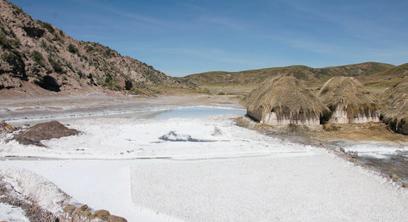
continuing into the present as our global climate becomes more unstable.
While the mining sites, processes, and minerals of today’s quest for transition metals may look different from the conditions that can still be witnessed in mines such as Potosí, it is imperative to continue to critically examine the impacts of mining upon living communities. After all, it is these communities, which include Pachamama, that allow mining, tourism, and other industries to exist in the first place. The faces, Traditional Knowledge, and insights of the communities on the frontlines of the Lithium Triangle have much to teach us about the true contours of what “green” technologies and economies mean for our relationships to a living world that deserves our stewardship and respect.
Bobbie Chew Bigby (Cherokee) is a Postdoctoral Research Fellow at the University of Waterloo, Ontario, Canada, where she researches the intersections between Indigenous-led tourism and resurgence.
This article is part of a series that elevates the stories and voices of the Indigenous communities and land defenders in the Lithium Triangle.
Cultural Survival Quarterly June 2024 | 15
Left:
A group of Marka Tahua traditional leaders standing on the Uyuni salt flat and looking towards Qujiry Island, Bolivia.
Right:
The primary area of salt cultivation in Carlos Mamani’s ayllu, or traditional Nation, which includes stacked salt blocks under straw covering to the right.
“FOR THEM, IT’S MONEY. FOR US, IT’S LIFE.”
Grassy Narrows’ 60-year Legacy of Poison
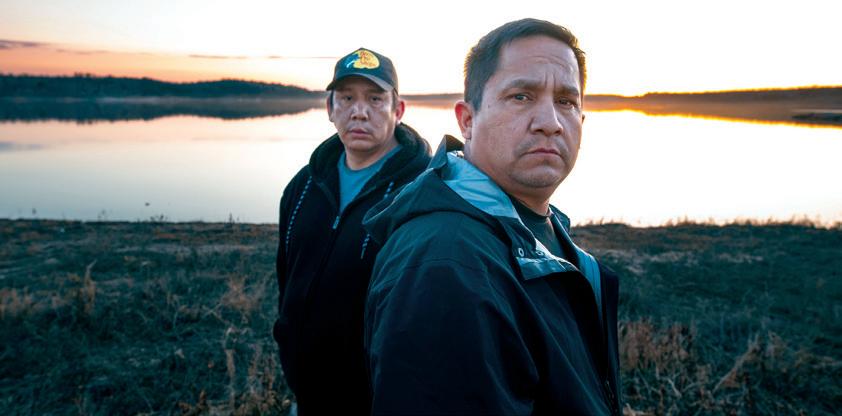
Mike Forbister and Robby Williamson Jr. of the Land Protection Team stand along the shore of Grassy Narrows Lake. Mercury from the Dryden pulp mill flowed into the Wabigoon River system in the late 1960s and early 1970s, contaminating the fish and poisoning the Grassy Narrows First Nation.
Brandi Morin (CREE/IROQUOIS)
The land guardian knows the intricate layout of his territory inside out. Mike Forbister (Ojibwe), like his father and grandfather before him, has memorized every vein of the complex English-Wabigoon River systems.
He and his colleague, Robby Williamson Jr. (Ojibwe), spend their days monitoring the territory of their homelands at Asubpeeschoseewagong First Nation (Grassy Narrows) in northwestern Ontario, Canada. Their focus, as part of the Grassy Narrows Land Protection Team, involves making sure the land is healthy. And that means keeping trespassers out, specifically industry. “This fight is important because we have to think about my kids, his kids, his grandkids,” says Forbister. “We have to make sure that they have a safe environment when it’s their turn to live here. We have to make sure they have good land, have their treaty rights. The majority of the reserve supports the no logging plan, no mining.”
Grassy Narrows is part of the Land Defense Alliance coalition, and even though they won’t be directly impacted by the Ring of Fire mining development in northern Ontario, many here are willing to protect their allies’ territory because they’ve already seen the devastating effects of industry. The provincial government’s plans for industrial development continue to be pushed forward without First Nations’ Free, Prior and Informed Consent, and without a comprehensive assessment of the impacts of multiple industrial projects in the sensitive ecosystems.
The Grassy Narrows First Nation is world famous because of a catastrophe first discovered in the 1960s: a paper mill plant in the City of Dryden, less than 150 kilometers upstream, released about 10 metric tonnes of mercury into
the Wabigoon River. Fish, especially the coveted walleye, are the staple diet of this Ojibwe Tribe, and have been for thousands of years. But the food source they once thrived on converted the mercury to methylmercury due to consuming smaller fish all the way down the food chain to the plankton. The older and larger the fish, the higher the mercury levels in their bodies.
Everyone is affected by the poison here. A 2022 study found that 90 percent of Grassy Narrows members suffer from mercury poisoning. Their symptoms are varied and include neurological problems, cognitive delays, and mental health struggles. Dryden Chemical evaded responsibility for what’s been called the largest industrial disaster in Canadian history by dissolving the company and reforming under new ownership.
“What is happening [with the mercury poisoning] is that we’re accumulating harm upon harm,” explains Dr. Donna Mergler, a top expert on neurotoxins and also a professor in the Department of Biology at the University of Québec at Montreal who researches the long-term, intergenerational effects of the poisoning from all angles: physically, culturally, mentally, and economically. “This was a welloff community. People worked the whole year round. It had 85 to 90 percent employment,” she explains. But the commercial fishing industry was wiped out here, and decades later the unemployment rate is close to 90 percent. “The idea of putting industry before people’s lives is something that our system has been doing for a long time,” Mergler says.
Grassy Narrows is home to the longest blockade in Canada. For the past 21 years, the community has successfully kept the logging industry out. They’re serious about enforcing treaty rights and holding governments to their side of the deal, says Joe Forbister (Ojibwe), manager of
16 | www.cs.org
All photos by Geordie Day/Ricochet Media.
the land guardians’ program. “They have a duty to consult. We will force them to listen to us. We are a Nation that signed a treaty with Canada. We know we’re a partner. And one can’t do something without the other one knowing. It’s been logging, and then mining, so it’s rolled into a fight against mining,” he says.
The Government of Ontario has handed out nearly 4,000 mining claims and permits in Grassy Narrows territory without the knowledge or permission of the Nation. The challenges the community is facing are extreme, but they’re putting themselves on the line to help protect other First Nations territories through a new allyship called the Land Defense Alliance. The alliance was launched in 2023 through a mutual agreement between Grassy Narrows, Kitchenuhmaykoosib Inninuwug (Big Trout Lake First Nation), Wapekeka First Nation, Muskrat Dam First Nation, and Neskantaga First Nation. The coalition demands respect for First Nation sovereignty, decision-making powers, and the removal of free entry. As part of Ontario’s Mining Act, this system allows mining companies to stake claims to Indigenous lands without notifying the Nations or obtaining their Free, Prior and Informed Consent.
Specifically, the Land Defense Alliance was formed to assert Indigenous rights due to the lack of consultation regarding the multi-billion dollar Ring of Fire development. The Ring of Fire in northern Ontario is a vast area rich in mineral deposits, including chromite, nickel, copper, and platinum, essential for facilitating the so-called green energy transition. It has the potential to become one of the largest mineral developments in the province’s history. But local First Nations have serious concerns about the environmental impact of mining activities on the land and water in the area. Aside from potential contamination, building roads would facilitate the mining process, damaging the fragile ecosystem that makes up northern Ontario’s peatlands.
Despite several protests across Ontario, Indigenous sovereignty rights in the Ring of Fire continue to be ignored by the provincial government. Grassy Narrows Chief Rudy Turtle believes Ontario’s provincial government is refusing to meet with the Land Defense Alliance because they see it as a waste of time. “I think they feel that it’s pointless sitting down with us because we won’t change our position. Well, they won’t change their position either, but at least let’s hear each other. We may not agree, but let’s just talk.”
Prospectors have staked thousands of new claims on these territories, exploiting Ontario’s antiquated “free entry” mining system that allows companies and individuals to stake mining claims on First Nations lands from the comfort of their offices without gaining the consent of the Indigenous people who live there. Prospectors are not required by Ontario to give any notice to First Nations until after the claims have been registered and are in force. Conversely, Ontario does not inform prospectors which First Nations’ land they are staking until after the claims are purchased.

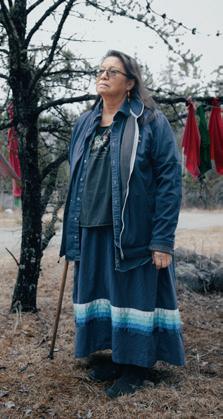
With mercury poisoning and much of their territory having been wiped out by logging, Chief Turtle doesn’t trust the rhetoric around reconciliation because there’s “just a lot of talk and no real action. Why not just keep the land as it is and preserve it for ages instead of just ruining it? They don’t clean up after when they’re done, they just basically leave. And the government doesn’t really hold them accountable. It’s getting harder and harder each year to keep them away. For us Native people, we always end up with the short end of the stick, and we’re always left behind.”
Yet, against all odds, there is a resurgence of strength, spirituality, and culture unfolding in Grassy Narrows. Judy Da Silva, an Elder and environmental health coordinator for the Nation, is helping lead the way for community members to connect with powerful Ojibwe traditions. She leads full moon ceremonies and prayer gatherings and attends Sundances held near the former grounds of the logging blockade. “We’re really in a lot of trouble,” she says. “There’s a hunger for the minerals that are in our territory. And the bottom line for them, it’s money. For us, it’s life. They, as consumers, have to become more responsible consumers, not just for Grassy, but for Mother Earth and for us as human beings. Again and again, we are at the frontier, the center of the destruction of the environment. And we have to live with it. And that’s why we contest it. We’re using our tobacco and our really humble prayers to try and fight that system. It feels like we’ll never win, but we use our spiritual way of life as a way of fighting it.”
Read the full article at: tinyurl.com/grassynarrow60
Brandi Morin (Cree/Iroquois/French) is an award-winning journalist reporting on human rights issues from an Indigenous perspective.
Right: Judy Da Silva stands in front of the Grassy Narrows blockade, preventing clear-cut logging and mining on her traditional territories for more than 20 years.
Cultural Survival Quarterly June 2024 | 17
Left: Elder Bill Fobister walks along the shore of Grassy Narrows First Nation.
PROTECT INDIGENOUS ENVIRONMENTAL DEFENDERS STRATEGIES TO
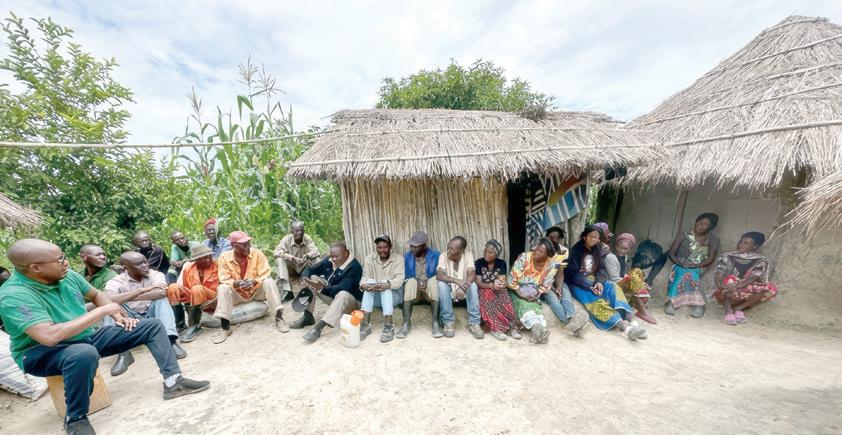
Chilekwa Mumba meeting village Elders about problems faced in the communities regarding agriculture.
Below: Chilekwa Mumba on the Kaufe River bank in Zambia, conducting water and sediment testing.
Chilekwa Mumba (BEMBA)
From my experience, I have found that environmental defenders continuously face many enemies who, according to the stakes, can and will go to great lengths to derail or com pletely stop environmentalists from carrying out their work. Right from the heart of govern ments whose powerful official reach has the capacity to facilitate powerful surveillance to powerful corporations that are motivated purely by profit and far less by morals, opponents will go to great lengths to advance and protect their profit interests. Unofficial and unlimited budgets are made available to influence Indigenous communities, individuals, NGOs, the media, and, of course, powerful politicians to lobby on behalf of these interests to counter the work of Indigenous environmental defenders.
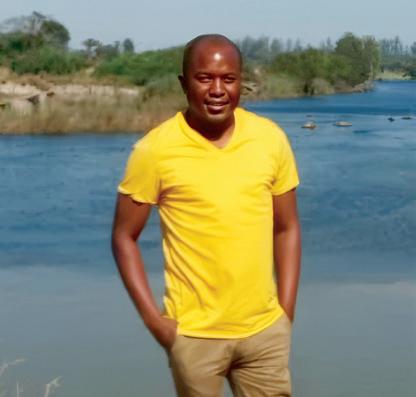
This scenario reveals a complex and sinister face of the would-be enemy of environmental defenders. However, understanding these points gives environmental defenders the opportunity to devise and implement countermeasures as they go about their critical work.
The Importance of Individual Security Awareness by Environmental Defenders
It is imperative to realize that the defense and security of environmental defenders must begin at an individual level. Due to the constant threat of aggression by corporations whose interests place the environment as secondary, environmental defenders will do well to be aware that despite the good and noble intention of their work, the enemy always lies within—potentially even in the same communities that environmental defenders are trying to protect.
always important to take stock of conversations with colleagues, noting their reactions and double checking how information flows. A practical example is making confidential plans for a protest, and then double checking to see if that confidentiality holds within that inner circle of colleagues before it is filtered out to the rest of the community. If confidentiality does not hold, the leading environmentalist must take measures to identify the “enemy within.” Sometimes, the consequences of not having security and self-awareness at the individual level are dire and completely take away from the objective of protecting the environment. Undue influence on Indigenous communities from counter interests may turn the environmental defender into a pariah of that very community on a straightforward, but easily believable, notion that environmental defenders are against progress for the community.
18 | www.cs.org
All images courtesy of Chilekwa Mumba.
Community as a Source of Insulation or Protection for Environmental Defenders
Communities play a critical role in protecting environmental defenders. Of course, if the environmental defender is originally from and stays in his or her Indigenous community, the community will provide insulation and protection to one leading an effort to protect the environment. However, if an environmental defender is not originally from that community or has been away from that particular community for a while, it is imperative for the environmental defender to immerse themself into the culture of the community and become an absolute part of it. This cultivates camaraderie and trust that provides a refuge of security to environmental defenders, and it becomes easier for communities to rise up in defense of environmental defenders being harassed or arrested by using various forms of protest.
Incorporating the communities in this work of protecting oneself as part of a strategy to protect environmental defenders has limitless benefits. I vividly recall the experience of my colleague and I being arrested and thrown into jail cells. In the middle of all this, women from the community began to organize themselves and marched in protest to the police station where we were detained. As the women were organizing, the police caught wind of it and decided they did not want to attract trouble. We had been given the indication that we were going to spend the night in detention, but within hours we were released. I do not doubt that this resulted from the community deciding to rise up against our detention, knowing that I was leading an effort to protect their environment.
Association with Environmental Indigenous Rights Movements and NGOs
It is also strategically important for environmental defenders to have trusted and like-minded environmental and Indigenous movements within their network, such as Cultural Survival. In addition to the capacity to bring such important issues to light, interactions with supportive organizations and associations are valuable to the defense of environmental defenders, as these interactions are opportunities to learn different strategies for their overall protection. Environmental movements have practical resources that provide a platform to interact with others who can share their experiences. These learning experiences are in tune with the current challenges to environmental defenders due to the foreseeable acceleration of ecological issues as we move towards the just transition to a green economy. These movements provide a critical voice that will always be useful in cases of intimidation of environmental defenders. My personal experience with organizations such as Cultural Survival and Southern African Resource Watch, both formally and informally, gave me invaluable insight into how to protect myself as I defend environmental and Indigenous rights.
Keeping Lines Open with Environmental and Human Rights Lawyers
Threats to environmental defenders come from many angles. It is not uncommon to unjustly come into a cookedup conflict with local laws of, say, trespassing, or what is later prescribed by compromised law enforcement as “illegal meetings.” Keeping environmental law firms and lawyers on call in one’s corner is very important as a defense strategy. This gives the environmental defender a layer of protection from undue harassment during the course of one’s work. Upon my arrest, I contacted friendly environmental lawyers who would have proved useful if things had not been resolved so quickly.
Befriending Influential Journalists
Influential journalists can bring immediate attention to the cause and protection of environmental defenders, and cultivating relationships with them is quite beneficial to the protection of environmental defenders. I had at least two journalists who were available to put in the news media anything to do with me being harmed. In fact, they had wanted to do an exclusive on our arrest, but at the time I felt it would take away attention from the real issues that needed to be amplified in the media. At the community level, journalists disseminate information on their various platforms that strengthen the communities’ capacity to quickly rise to the defense of environmental defenders.
Training with Nonprofit Organizations that Specialize in Security
I have come across specific nonprofit organizations that will train environmental defenders on security and surveillance issues. I was contacted by the NGO Open Briefing, which specializes in support and resources “to empower people and communities to agitate and advocate without fear of attacks and reprisals.” My team and I underwent training that has been useful to the sensitive components of our work as we gather information in Indigenous communities. After the trainings, we were able to operate better in terms of self-defense and security. A few times, we identified certain elements who were tailing and surveilling us. This has improved our practice of taking necessary precautions. Threats present themselves in different ways, shapes, and forms. Having formal training helps in identifying threats that pose a detriment to progressing the work of environmental defense. I strongly recommend this training to environmental defenders who find themselves in precarious positions.
Chilekwa Mumba is a Zambian community organizer and environmental activist who organized a successful lawsuit against UK-based Vedanta Resources, owner of the subsidiary Konkola Copper Mines in Zambia’s Copperbelt Province, in response to pollution and environmental damage. In 2023, he was awarded the Goldman Environmental Prize.
Cultural Survival Quarterly June 2024 | 19
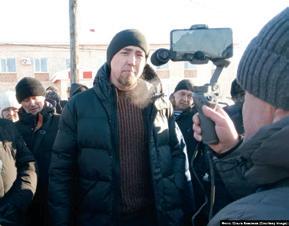
On January 17, 2024, Fail Alsynov (Bashkir) was sentenced to a fouryear prison term in Russia for his political activism.
FAIL ALSYNOV DEFENDER OF BASHKIR LAND, LANGUAGE, AND RIGHTS
Batani Foundation
On the southern slopes of the Urals, located within the territory of today’s Russian Federation, lies the land of Bashkortostan, a country historically renowned for its national heroes, defenders of the land. From this beautiful and hospitable land hails Fail Alsynov (Bashkir), a land defender and cultural activist of the Bashkir Peoples. Alsynov is currently the most prominent activist in the field of environmental protection and human rights from the Republic of Bashkortostan, and has been actively engaged in defending the land, language, and cultural sovereignty of the Bashkir people for several years. His unwavering and active stance has earned him both wide recognition and fierce resistance from the Russian authorities.
Born in 1986 in the village of Yuldybayevo, Zilairsky District of the Republic of Bashkortostan, Alsynov is the second eldest son in his family, with two brothers and a sister. He studied at Bashkir State University, majoring in history. In early 2011, he began working as a specialist at the World Kurultai of Bashkirs, where he worked until the beginning of 2014 when he was dismissed due to unwillingness to work with the new management.
Alsynov began his public activities in 2008, advocating for national liberalism by joining the Bashkir nationalist organization Kuk-Bure. In late 2010, he was elected as the first deputy chairman of this organization and remained so until 2014 when he left the organization. In 2014, along with other members of Kuk-Bure, he founded a new public organization called Bashkort.
As the leader of Bashkort, Alsynov became an organizer and initiated a series of high-profile events to protect the natural and cultural heritage of the Indigenous people of Bashkortostan. In 2014, when discussions began about the development of the Toratau Ridge, Alsynov, as the de facto leader of Bashkort, became one of the organizers and participants in protests against the destruction of this natural monument. Thanks to the efforts of activists, the development of Toratau was halted.
Alsynov was at the forefront of protests aimed at preventing the exploitation of environmentally significant objects sacred to the Bashkir people, including the Kushatau mountain range, around which a large-scale conflict erupted in 2019-2020 among residents, authorities, and the Bashkir
soda company, which planned to develop limestone deposits in this area. Residents were convinced that the development of deposits in the vicinity of Kushatau would “kill the nature” of this region. In May 2020, the Supreme Court of Bashkortostan declared Bashkort an extremist organization and banned it. Representatives of the organization unsuccessfully appealed the court’s decision, and in September 2021 they filed a complaint with the European Court of Human Rights.
“I am stepping out to protect our rights,” Alsynov said at the time. “Our events are organized with thoughts of the republic, of our future, because we care. But because of the policy that is being conducted towards us, we have to stand against the authorities. If the internal policy were led by people who understand us, we would not be in this situation. If the authorities could find common ground with all our public figures in solving various problems, and these problems are urgent, [if] we would sit at one negotiation table [to] discuss and find a direction for everyone to work towards, then the people of the republic would be much better off.”
In 2020, Alsynov and members of the now-banned Bashkort also participated in protests against the development of Mount Kushatau. As a result of these protests, the development company abandoned its plans. Work on Kushatau was halted and the mountain was designated as a protected area. In 2023, Alsynov spoke out against the development of gold deposits in the region by the Eurasian Mining Company. He took part in protests against plans for geological exploration in the Irindyk mountain range in the villages of Temyasovo and Ishmurzino, arguing that such activities were a threat to the region’s natural heritage and expressing concerns about the unfavorable living conditions in the region. While other Peoples have a homeland they can return to in case of an ecological catastrophe in Bashkortostan, the Bashkirs are on their historical homeland, and would have nowhere to go.
“Armenians will go back to their homeland . . . Russians will go to their Ryazan, Tatars to their Tatarstan, [but] we cannot resettle; we have no other home,” he said.
Alsynov argued that coal, copper, zinc, and gold are natural resources of the region, and that mining companies should invest a significant portion of their profits in the development of local economic and social infrastructure. His position was that resources extracted from the region should benefit the local population and contribute to
20 | www.cs.org
improving their living conditions, and his proposals aimed at ensuring balanced and sustainable development of the region by considering the interests of the local population. Alsynov also supported the idea of implementing social programs to improve the quality of life for the local population, including the construction of roads, schools, hospitals, and other social infrastructure.
Alsynov also advocates for the revitalization and development of language as an important part of national identity. He participated in protests against federal education reforms that made classes in national languages optional, seeing it as a direct attack on the Bashkir language and an intention to gradually eradicate it. He has also organized various actions and rallies to protect the Bashkir language, such as the “Ring of Life” Campaign that included a flash mob near the Toratau Ridge and the Days of Bashkir Culture. These events aimed to draw attention to the need to revitalize the Bashkir language and culture and support the language and cultural rights of the Bashkir people. He actively advocated for the official recognition of the Bashkir language and its widespread use in public life.
Alsynov has been openly critical of the disproportionate impact of the war in Ukraine on young Bashkir men, calling it a “genocide against the Bashkir people.” He also condemned the treatment of ethnic minorities by the Russian government, accusing it of prioritizing the interests of ethnic Russians over the interests of groups such as the Bashkirs. He advocates for the autonomy and self-determination of the Republic of Bashkortostan, seeing it as critically important for the preservation and development of the Bashkir people.
In 2023, Alsynov was charged with inciting interethnic strife for a speech criticizing the impact of gold mining on the Bashkir population. The case against him was initiated at the request of the head of Bashkortostan, Radiy Khabirov, who accused him of using extremist and separatist rhetoric. He was charged with “inciting hatred and humiliating the dignity of a group of persons based on race, nationality, language, and origin.”
Alsynov was pronounced guilty on January 17, 2024, in the Baimak District Court and sentenced to four years in prison. Immediately after his sentencing, he declared, “I do not admit my guilt. I have always fought for justice, for my people, for my republic.” Thousands of people took to the streets in support of him and called the charges politically motivated. The protests were some of the largest in Russia since the country’s invasion of Ukraine, underscoring the deeply rooted tension between the Russian government’s attempts to maintain control over ethnic republics and the aspirations of minority groups, such as the Bashkirs, to protect their land, language, and rights.
Alsynov’s dedication and persistence to these goals have made him a hero to many in Bashkortostan, and the actions of the authorities against him have only strengthened support for the activists and the struggle of the Bashkir people for self-determination.
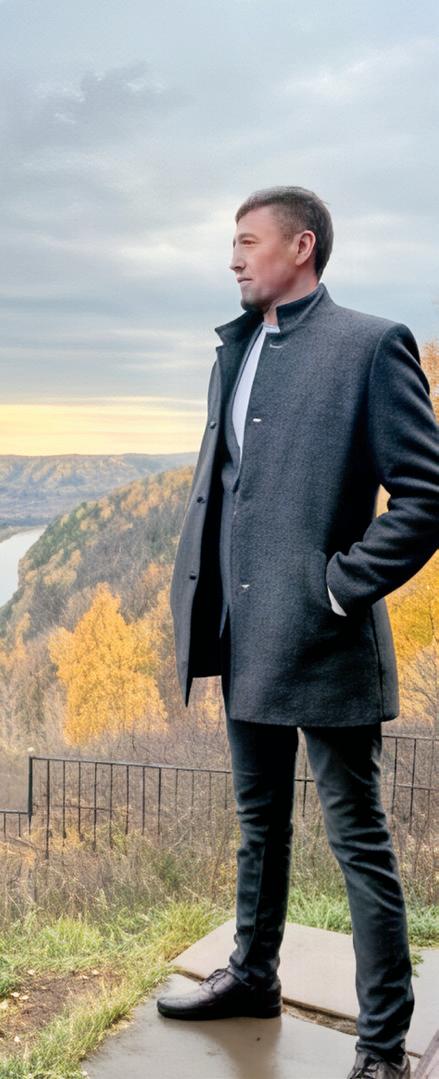 Fail Alsynov before he was imprisoned for his work defending Bashkir identity, language, land rights, and the environment.
Fail Alsynov before he was imprisoned for his work defending Bashkir identity, language, land rights, and the environment.
WE ARE UNDER CONSTANT THREAT
Rayen Rupayan (MAPUCHE)
One legacy of colonialism is that our territories are constantly under threat.
Chile was built on the usurping and dispossession of Indigenous territories, which reduced our population. As Indigenous Peoples, we have always been repressed and dispossessed in a systemic way. Being a defender of the land corresponds to following a path of struggle of our ancestors, a struggle that dates back centuries to revitalize our own culture and territory.
Today, the climate crisis and the effects of extractivism, where they are carried out in Indigenous territories, have extreme significance for the communities. The land is fundamental for our communities. We understand it not only as land but as territory, and we have a vital spiritual and emotional connection to it. We are not separated from the territory, but we are part of it. Therefore, the effects on the Earth also affect our lives and spirituality. The territory is an extension of our body; it is a relationship of equals. I am part of Wechekeche Ka Itrofillmongen, which translates to Youth and Biodiversity. It is an organization that promotes spaces for Indigenous youth, making visible their diversity and recognizing their rights, needs, and ways of providing solutions. We are young people working for the defense and promotion of the rights of biodiversity, ecosystems, and nature, of people and environmental defenders, and of the powers inherited by our ancestors and families.
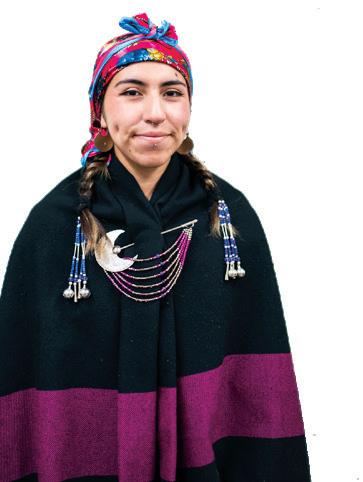
Wechekeche Ka Itrofillmongen is a safe space for reunion and the construction of our own identity. We are making visible the problems of different communities, whether from Chile or other countries, at all levels, from local to international. We are constantly working to communicate with other organizations and communities to be able to know and offer our support.
Since 2020, we’ve been working on issues related to transition mineral mining and the extractive industry. We’re currently
working on a series of podcasts about territorial defense that trace the supply chains from extraction to where these products end up. We’re talking about who is benefiting from the extraction of these minerals, about wealth, and also other financial needs for the communities.
The actions we have carried out through Wechekeche Ka Itrofillmongen have both a cultural and environmental focus, understanding that this will be fundamental in our growth as Indigenous youth and in the defense of our territory. We have visited communities across the country and have held nutram (conversations) with these communities about the extractive projects that threaten our territories. We have held workshops and interventions in different spaces, in addition to creating social networks where our people are informed about our actions and the problems of each territory we visit to be able to make visible what moves us.
As defenders of the land of Indigenous Peoples and young people, we find ourselves under a constant threat. Land and rights defenders are oppressed by the State, which calls us terrorists. We are oppressed and have been stripped of our territory, language, spirituality, and culture. As young defenders, we are more exposed to threatening situations, whether by the State or the extractive industry. Demonstrating and achieving impact or change means that we are an easy target and that it can cost us our own lives.
Our fellowship project, “Ti rüpu ingkakeleaiñ itxofill mongen” (The path of defending biodiversity), seeks to strengthen the capacity of the group members through activities and meetings to raise awareness about the need to defend and protect our territories affected by the so-called green extractivist model that promotes electric cars and other methods of electro-mobility targeted to young people in urban areas.
Through this project, we aim to remind everyone that young people have a vital role to play. We are trying to claim the same important leadership roles that we have in our communities within the power structures. Historically, our participation has been limited. We are working in this space to reclaim the identity and leadership of Indigenous youth in these spaces. We need to focus on taking that power back because those changes have to be made with us, not without us.
Rayen Rupayan (Mapuche) is a 2023 Cultural Survival Indigenous Youth Fellow and member of Wechekeche Ka Itrofillmongen in Chile.
www.cs.org
Rayen Rupayan. Photo by Jamie MalcolmBrown/Cultural Survival.
ADVOCATING FOR INDIGENOUS PEOPLES’ LAND RIGHTS THROUGH THEATER
Simson Kapembe (SAN)
We are known as hunters and gatherers. We lived a nomadic way of life, gathering bush food to feed our families. We use different types of bush trees as traditional medicine to cure our family.
Our traditional authorities in our jurisdiction area in Bushman land sell our land to non-Indigenous people. My community has a very small piece of land in Tsumkwe, which the Namibian government declared a place of residence for the Bushman people. Some communities find it difficult to collect bush food anymore since non-Indigenous people hold 80 percent of the best fertile land. The best areas where the San used to collect their bush food are now fenced off, and communities are starving.
Indigenous people are not free in their own land. We depend on it for survival, collecting bush food, and growing agriculture, and getting traditional medicine from it. I became a land defender when the non-Indigenous people started taking our land. We tried talking to our traditional authorities, who suggested we ask the government to intervene. They have done nothing.
Between 2020–2023, we had oil and gas fracking on our Indigenous land and we were forcefully removed without compensation. During the COVID-19 lockdown, the government allowed a Canadian company, Recon Africa, to conduct drilling. We advocated for the government to overrule the decision and put the oil and gas fracking on hold. The government ruled in favor of Recon Africa to continue their fracking.
Why do we never benefit from the resources of our own country? We have conservancy projects that are supposedly community managed, but our conservancies are being managed by non-Indigenous people and they run the conservancies how they want. We, the community, never make decisions or have people who can manage. Indigenous people have knowledge in the areas of community resources management and in tourism and hospitality management. Our government manages all wildlife in our jurisdiction in the national parks and in conservancy boundaries where we are the custodians of the land. When the hungry community hunted, they declared hunting illegal and we were arrested. Meanwhile, they have not put any effort into our communities.
Recently, I started advocating for Indigenous Peoples’ land rights through theater and by sharing these Indigenous

land issues at local and international media platforms. Our government sees this advocacy as a threat because they say we are reporting them to the international community and that we do not want to give land to non-Indigenous people. Our youth face under-development. We don’t have activities that keep us busy and off the streets. Youth face high rates of unemployment, alcohol, and drug abuse. The youth in Tsumkwe need training and funding to start their own businesses, especially in the sector of agriculture, to ensure food security and to fight injustice such as human rights violations.
We need funds to train Indigenous youth in areas of human rights defense, climate justice, and land rights defense. We need the international community to support us by sending investigating teams to Namibia and engaging with our Indigenous Peoples on the ground to document the issues that Indigenous people face. The international community can support people like me who are youth activists to become lawyers, Indigenous human rights defenders, land rights defenders, environmental lawyers, climate change injustice lawyers, and Indigenous language rights lawyers.
My current fellowship project is a theatrical intervention. Through theater production, we wanted to have a dramatic dialogue to address the impact of human rights violations that our community can understand. The second phase is community engagement. We are working on creating videos, audio recordings, images, and interviews to share and gain support to help us to fight the battle together.
Simson Kapembe (San) is a 2023 Cultural Survival Indigenous Youth Fellow and Chairperson of Tsumkwe Constituency Youth Forum from Tsumkwe, Namibia.
Cultural Survival Quarterly June 2024 | 23
WE COME FROM WITHIN THE LAND
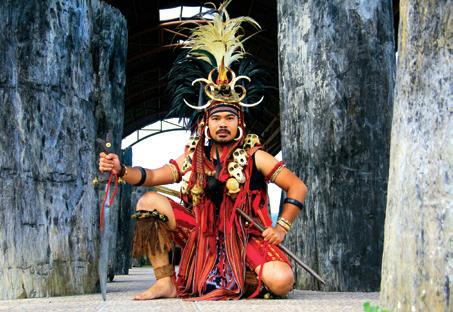 Gerard Tiwow (MINAHASA)
Gerard Tiwow (MINAHASA)
We, Minahasan, view everything that nature provides as historical sites that must be protected by all means. Minahasa is the name of the union of nine Tribes that inhabit the northernmost tip of the Minahasa peninsula on the island of Celebes, Sulawesi, Indonesia. We are currently facing many threats to our territories. Our water resources are heavily polluted, our springs are experiencing drought, our forests are being cut down en masse, mountains, and hills are being demolished for mining activities and construction, and our historical sites are in danger of being erased entirely from the memory of the people.
In Minahasan cosmology, we believe that we come from within the land. In our creation lore, the first woman was named Karéma. She prayed to God for a companion, and a second woman named Lumimuut emerged from a rock. This cosmology signifies that we come from within the land, and the land itself is us. There’s a pokéy (saying) that is often recited during specific rituals: mamuali wia un tana’ mawuri wia un tana’ (from the land we become, and to the land shall we return). We have a millennia-old practice of putting a newborn baby’s umbilical cord inside a kuré’ (clay pot) and burying it in acknowledgment of our unity and connection with our ancestors. We also acknowledge that there is a living being, or at least a living energy, within the land.
Today, the Tombulu’ People are facing a land loss problem, especially the loss of natural landscapes and forests. Most of the hills have been lost for extraction of minerals, which are very abundant. The Tonséa’ People have suffered deforestation of hectares of land for mining exploitation activities.
North Sulawesi Province has become one of the priority development areas for the central government of Indonesia. Airports, roads, dams, and other infrastructure are being built at a very fast pace to boost our regional development. We are pleased that the central government has made an effort to build infrastructure for the people here and to boost the economic growth of our province. However, the development is a double-edged sword; with its benefit also comes the negative impact that has challenged Indigenous Peoples’ rights.
National strategic construction and land privatization are also impacting our lands. People of Kayawu and Tara-tara from Tombulu’ are losing their land for the construction of a private road. The people of Kinangkoan in the Tonséa’ Tribe almost lost countless waruga (ancient stone sarcophagi) and natural water springs for dam construction and a toll road, both of which are part of national strategic construction. Most historical sites, such as waruga have been demolished for construction work, in some cases, destroyed beyond recognition.
There have been other conflicts. Tontémboan farmers of the Kélélondey farm clashed with the Indonesian Army when hectares of their farms were suddenly occupied by the military for training grounds. People of Kalaséy and Séa’ from the Bantik and Tombulu Tribes often clash with the Indonesian Police and the government because of the installation of the police training area and the building of a government-sponsored university that stripped them of hectares of farm fields.
In the pre-colonial era of Minahasa, there was a form of collective land ownership named kalakeran, or kalakezan Each awu (family) and taranak (clan) shared the same land, and they took turns with the agricultural activities. Most importantly, the land was not to be sold or traded. However, the colonizers erased this practice almost entirely. We believe that the land is our living space, a space where we live and give us the life that we have. Losing land is the same as losing our life; our land is our identity, and natural and man-made historical sites symbolize our civilization. If we lose them, there will be no trace that we ever existed.
I left my community in 2011 to study in Bogor, West Java. Early on, I did not identify as a land defender but as someone wanting to connect with my Minahasan diaspora.
24 | www.cs.org All photos courtesy of Gerard Tiwow.
Gerard Tiwow in Minahasa traditional attire.
In 2019, I moved to Jakarta. I continued to engage with my fellow Minahasan People and helped develop a sanggar (art community). During my time there, I gained more insight into the current socio-economic and cultural state of Minahasa. My brothers and sisters shared stories of how they lost their lands because of modernization and urbanization.
I returned to my hometown in 2021 and joined Tou Mu’ung Wuaya, an Indigenous school that protects our Indigenous knowledge, systems, and practices, which includes the importance of protecting our land property and rights as Indigenous people. I am also connected with Aliansi Masyarakat Adat Nusantara Sulawesi Utara (North Sulawesi Chapter of the Indigenous Peoples’ Alliance of the Archipelago). During my engagement with the Alliance, I learned how to take action to protect our land. I am fortunate to have mentors who give me valuable technical and practical knowledge on how to advocate for current development challenges that Minahasans face in our territory.
Our community works in three ways: the first is by becoming a part of the system and making change from within. The second is through advocacy and formal negotiation to find a point where the counterpart’s interest does not interfere with our rights as the stewards of the land. Third is confrontational action, where we hold demonstrations to fight for our rights and existence. My brothers and sisters on the frontlines often have their human rights violated by police or the military.
When several hectares of farms that fed three villages were submerged, and countless waruga were intentionally demolished for the construction of a dam, we were enraged and demanded that the central government, through the then-Ministry of Public Works and the provincial government, rehabilitate the demolished waruga with proper and just compensation for the people who lost their farmland. This action was a success. The government redesigned the concept of the dam into a cultural park, and the demolished waruga are being restored.
Also in progress is the drafting of a regional Indigenous Peoples law (Peraturan Daerah Masyarakat Adat) in the Southeast Minahasa Regency. This law will protect the human rights and land rights of the Tonsawang, Pasan, and
Ponosakan Tribes. Despite some resistance, the law is near ratification. This effort is a part of our vision to change the system from within.
In my hometown of Tomohon, there are ongoing Indigenous youth initiatives. Weresi Un Zano (Cleaning the Water) is working to clean up the rivers and springs, plant trees, and take action to ensure our water resources will not be compromised. We realize that we are unable to put a complete stop to mining activities, road construction, and land privatization, so we are working to ensure that the mining activities do not expand further, that roads are built with respect to our sacred forests, and that land privatization is taking measures to not tamper any further with the rights of the Indigenous people.
My Cultural Survival Youth Fellowship project is a pilot project that aims to restore the Indigenous identity of our people. The majority of our people can no longer speak their native language, and as we know, language is a fundamental aspect of one’s identity. The loss of historical sites also causes people to question their true identity. Through workshops, seminars, and cultural events, we actively involve community members, especially youth, in learning and using Indigenous languages, fostering pride and connection to their heritage. Working closely with Elders and language experts, we gain valuable insights into linguistic nuances and cultural significance, which guide our language revitalization efforts.
Alongside language revitalization, we conduct activities to document oral histories, record traditional arts, and create digital archives, ensuring the preservation of cultural knowledge. We advocate for the integration of Indigenous languages into formal education, developing resources and materials for language learning, and promoting awareness and appreciation among younger generations. Through advocacy, awareness raising, and ongoing monitoring, our project contributes to the sustainable preservation of Indigenous languages and cultures, empowering communities to reclaim and celebrate their heritage for future generations.
Gerard Tiwow (Minahasa) is a 2023 Cultural Survival Youth Fellow from Tou Mu’ung Walak (district), Tombulu’ pakasa’an (Tribe), in the city of Tomohon, Indonesia.
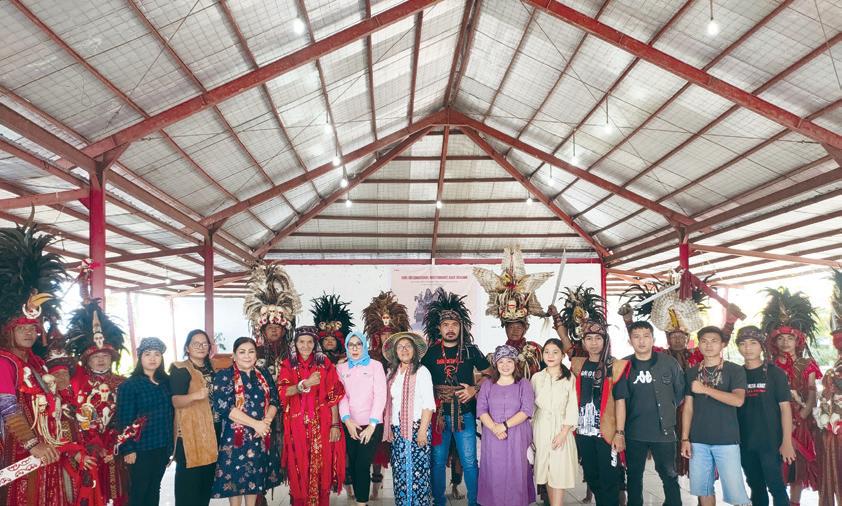
PUTTING PRESSURE ON PARAGUAY
Seeking
International Support
for Pa~ i Tavyterã Peoples

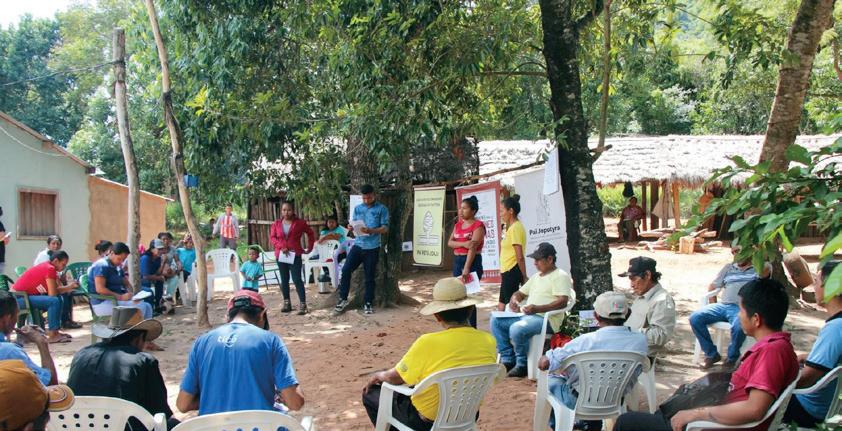
The community of Ita Guasu, Amambay, Paraguay and the leaders and representatives of various communities of the Guaraní Paĩ Tavyterã Peoples holding a preparatory session for their participation at the 23rd session of the UNPermanent Forum of the on Indigenous Issues.
by Gentileza Áry Ojeasojavo.
In April 2024, Rosalba Gómez Arce (Guaraní Paĩ Tavyterã) attended the 23rd session of the UN Permanent Forum on Indigenous Issues as a youth representative and spokesperson for three associations of Paĩ Peoples—Paĩ Reta Joaju, Paĩ Jopotyra, and Paĩ Rekopavẽ—in Paraguay. Currently, in her fifth year of law school, she is a young leader of the Paĩ Peoples’ women’s group. She has previously participated in other international meetings, such as the International Meeting on Indigenous Justice in Peru and the International Seminar on Women, Body, and Territory in El Salvador.
Gómez traveled to New York to bring to the world’s attention the urgent need to strengthen constitutional guarantees for the full exercise of her Peoples’ rights. She presented her community’s situation to State representatives and to a broader audience in the side event organized by Cultural Survival called “Indigenous Environmental Defenders in Latin America: Strategies to Support their Work and Protect their Lives,” alongside other Indigenous land defenders. Her aim was to share this information in the plenary of the Permanent Forum where many Indigenous Peoples’ community members share a brief statement with the Forum members, State representatives, Indigenous organizations, and other Indigenous communities from all over the world.
Though she did not have the opportunity to present her intervention at the plenary on behalf of her community, she did read it in the Indigenous Media Zone. “We are demanding that the Paraguayan State protect the rights of Indigenous Peoples. That the State intensify its efforts, and
adopt the necessary measures as soon as possible to guarantee the protection of the land rights of Indigenous communities, paying special attention to the land currently threatened by the crime of invasion of Tekoja Guasu Yvy Pyte and the sacred site Jasuka Venda belonging to the Guarani Paĩ Tavyterã people, [and to] urgently enforce compliance with the rules and regulations that protect forests and biodiversity, preventing deforestation and other illegal practices that put forests and the lives of Indigenous people at risk.”
Although Paraguay has signed international laws and agreements, they are not currently being fulfilled. This leaves Indigenous Peoples with a worrying lack of protection, especially in relation to their lands, access to health and education, and the preservation of their forests, on which their way of life and livelihoods depend. Gómez says, “As Indigenous Peoples, we are going through a time of great difficulty due to continuous violations of the… constitutional guarantee of our legitimate rights. We want to share our concerns about rising invasions of our land and the violence against our communities, which put our lives and lands at risk. In the last few years, three leaders have been killed for defending our land, and others remain under threat for events that we have repeatedly reported. Violent clashes related to evictions and conflict over land have been growing, affecting us as well as several other Indigenous Peoples. According to a UN report, in recent times, they have grown by 300 percent.”
The militarization of northern Paraguay began about 11 years ago, but it was only 4 years ago, in 2020, that it
26 | www.cs.org KOEF GRANT PARTNER SPOTLIGHT
All photos courtesy of Gentileza Áry Ojeasojavo
Photo
reached the territory of the Paĩ Tavyterã, especially in the surroundings of Jasuka Venda, the Sacred site of the Paĩ Tavyterã people, which is located in the northeast of Paraguay near the border with Brazil, their territory encompasses the Paraná River Atlantic Forest, a 7,000-hectare stretch of tall forest and the source of many important resources. Areas like this that are rich in natural resources have been the most recent targets of armed groups. There have been several attacks on community members resulting in three killings of community leaders, and some community representatives continue to receive anonymous threatening phone calls warning them to vacate their lands. The Public Prosecutor’s Office so far has not charged the actors of the invasions that seek to dispossess the community of their titled lands, and the families of those killed continue to wait for justice.
Speaking as a land defender, Gómez says, “We are being invaded by strangers who entered our community illegally, especially the community of Yvy Pyte. The people who lived in one of the community sectors are leaving, abandoning their houses and leaving their farms out of fear. Many are now in the city of Pedro Juan Caballero near the garbage dump, and many children are sick. In many cases, we have no formal titles to our lands, and we do not have documents that support us or define what and where our community is. We have a lot of eviction threats in our community.”
Paraguay is party to International Labour Organization Convention 169 and the national constitution does include language on the rights of Indigenous Peoples. However, Gómez says, “[Our rights] are not fulfilled. We have reached out to many institutions making formal complaints, but we do not have any answers [from our government]. Jasuka Venda was also invaded by the illegal people who planted their illegal plantations. Every day, they are cutting down trees and destroying forests. And it is very worrying to us as Indigenous Peoples because these are our sacred places.”
In New York, Gómez met with the permanent missions of the governments of Norway, the United Kingdom, Colombia, Denmark, and the Netherlands to speak about the situation her Peoples are facing. She says, “I have met many authorities, and I also participated in parallel meetings with young people. For me, it is very important to be here and bring a message of authority to my people with the hope that we can recover our communities. I think I have much more space [here] to talk to authorities. I did not imagine speaking with so many important authorities of each country. I have hope now that the authorities are going to send a message to the State of Paraguay so that it can manage these situations.”
In 2020, Cultural Survival and The American Indian Law Clinic of the University of Colorado submitted a stakeholder report to the Universal Periodic Review for Paraguay’s human rights record review in which we recommended establishing effective mechanisms for filing claims for the

restitution of ancestral territories, monitoring the implementation of Free, Prior and Informed Consent (FPIC) protocols, and addressing future Indigenous land rights cases at the domestic level in a way that is in compliance with the UN Declaration on the Rights of Indigenous Peoples. Paraguay accepted a series of recommendations made by France, Germany, Senegal, Switzerland, and others regarding Indigenous rights and land.
Gómez highlighted her gratitude for traveling so far away and being able to tell the world about the issues her community is currently facing, as there are many obstacles for Indigenous women leaders from Latin America to access these spaces if they do not have the opportunity to get a visa or even a passport. Young Indigenous women such as Gómez have a very important role in representing women to uplift their demands and the struggles they face so that the international community knows what is happening and can take action in solidarity.
Gómez says her message to authorities in Paraguay is “to see the struggle of the Indigenous Peoples, to listen to Indigenous communities, and to have them see how communities are being affected. I would also tell them to return our land because it is ours, and in Yvy Pyte where the invasion occurred, we have titles. In the titled lands, we are safe, and if we don’t have a title, we are in danger.”
The Keepers of the Earth Fund is an Indigenous-led fund within Cultural Survival, which is designed to support Indigenous Peoples’ community advocacy and development projects. Since 2017, KOEF has funded 311 projects in 41 countries, through small grants totaling $1,607,859, as well as technical assistance, which have benefited 328 Indigenous Peoples in total. www.cs.org/koef
Cultural Survival Quarterly June 2024 | 27 Quarterly June 2024
Rosalba Gómez Arce at the 23rd session of the UN Permanent Forum on Indigenous Issues in New York in April.
Photo by Mariana Kiimi/ Cultural Survival.
Speaking Out for Indigenous Rights and Cultures on Turtle Island TIA-ALEXI ROBERTS
Diana Pastor (MAYA KI’CHE’, CS STAFF)
Tia-Alexi Roberts (Narragansett), from the Turtle Clan, fell in love with dancing when she was four. A few years later, she learned how to dance from her cousin, Eleanor Dove Harris, and her aunt, Dawn Dove. Tia grew up in Rhode Island as a mixed person from the Narragansett Indian Nation. She spent her childhood in Exeter, West Greenwich, and Coventry, where she learned not just Native dancing but also about her culture from her family, especially her grandmother. “She took me to so many places, including the reservation, often going to luncheons, Tribal events, and pow wows,” Tia says.
In addition to her love for the arts, communications is another of Tia’s passions. She believes that sharing and learning one’s culture is both a privilege and a duty, and as an Indigenous person in communications, it is very important to disband misinformation and harmful rhetoric and prioritize sharing information about Indigenous issues in a positive light. “Our words and stories serve as our oral history,” she says. “Within my Peoples, most of our culture was not traditionally written in history books and has been passed down through word of mouth from our ancestors. These stories matter and help other territories with the same experience.” Land rights have always been a major concern for Tia’s reservation. While the Narragansett Indian Nation is on their ancestral lands, many other Nations have had that connection and kinship severed with their original land due to colonization.
Tia joined Cultural Survival in September 2023 as Editorial and Communications Assistant. “My current work gives me a sense of purpose and combines many passions and personal interests,” she says. “Cultural Survival is giving me the opportunity to learn Spanish to communicate effectively and expand my horizons with other Indigenous communities outside of the U.S., which is one of my long-term goals. I believe that working with other Nations will help us rebuild Indian Country. We can learn how to combine our strengths to help our Nations to thrive and protect our lands and cultures. Another longterm goal is to further grow my skills in project management,
marketing, grantmaking, and fundraising, as it has always been a dream of mine to start an Indigenous nonprofit dance program.”
Tia believes that Indigenous Peoples have to find a way to collaborate and communicate with each other because “we cannot fight a war if we are fighting amongst ourselves. Holding discussions, webinars, and conferences . . . are all valuable and are starting points to larger initiatives.” She also comments, “It is our duty to amplify our perceptions to foster growth and improve our circumstances for those who come after us and in honor of those who came before us, and to enforce our rights as Indigenous Peoples.
Tia says she is inspired by her grandmother’s honesty, kindness, and the joy that she spreads to others, her grandfather’s realism, wisdom, and oversight, and her Aunt Paulla, who shares many of these same qualities. “Ultimately, my ancestors and Elders serve as my inspiration, as they truly are the pinnacle of my world,” she says, adding that she also admires Loren Spears (Narragansett), Executive Director at Tomaquag Museum; Silvermoon Mars (Narragansett), Assistant Director at Tomaquag Museum; Dinalyn Spears (Narragansett) Director of Community Planning and Natural Resources at Narragansett Tribal Nation; Shawna Yazzie (Choctaw/Chickasaw), President and Founder of NDN Companies; and Larry Yazzie (Meskwaki/ Diné), Native Pride Productions Founder.
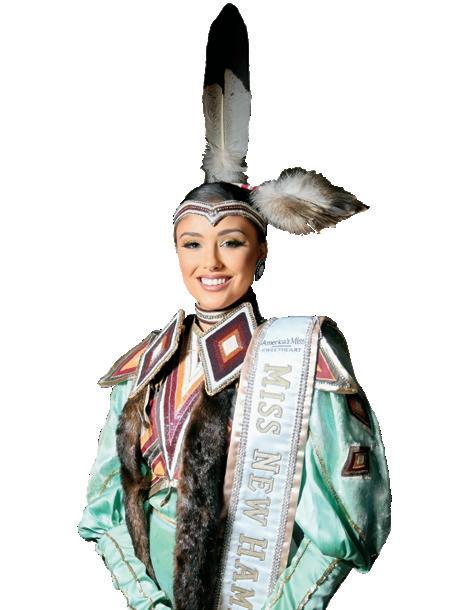
Tia is also the reigning Miss Sweetheart America 2024, and is the first Indigenous woman to compete and capture the national title. “I can attribute my public speaking abilities to pageantry, which hasoffered me many opportunities to grow my network and to elevate my ability to speak about my platform, ‘The Art of Being Indigenous.’ Without pageantry, I would not have gained the courage to do what I do today.”
In her free time, Tia enjoys reading, writing, beading, and making regalia. She plans to continue working for Cultural Survival and with Native Pride Productions and eventually to manage a dance program.
“I am so happy to have found a place where I feel I can use my talents to help others, which is also something I’ve dreamt of for a long time.”
28 | www.cs.org STAFF SPOTLIGHT

OUT OF PLUMAGE ARTE PLUMARIO KOZAMALOTL
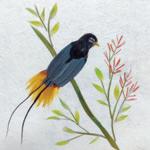
Rubén Flores Apaez (Nahua) was born in the state of Guerrero, Mexico, in a community called Cuahuilotla. He and his family emigrated to the state of Morelos when Flores was five years old. “Since I was a child, I have always appreciated and admired birds. I remember the first ones in the corral and some wild ones singing with their color and brightness in their feathers,” he recalls. At the age of 22, Flores joined a traditional Aztec and Mexica dance group in Cuernavaca, Morelos, which opened the door for him to feather art. “It all started 25 years ago when I was learning traditional dance. I started making pieces for the exclusive use of dance and for our group. Over time, I mastered the [glue] pen, and I created other ornamental pieces that could be used by anyone. As a person who likes feathers, after investigating the techniques and materials that were formerly used in Mexico, I began to create more elaborate pieces such as landscapes or people with feathers,” he says.
For more than 18 years, Flores has been working with Gastón Aguilar as part of Arte Plumario Kozamalotl. “Our current focus in our work is mainly the representation of birds. We have had the opportunity to participate in different events in Mexico. In the beginning, we participated in some contests and obtained awards and recognitions. We have had the opportunity to show our art in Guatemala, Italy, and, in recent years, in some places in the United States. Our work gives continuity and promotes an art that refuses to be lost. With crafts, we express our feelings and ways of perceiving life, and they are also sources of income for our families,” he says. Feathers have been used by many Indigenous cultures around
the world for ceremonial, ritual, and traditional purposes. Flores says his work represents “The taste for birds and their plumage; the continuity of an art that was highly appreciated and admired in Mexico and that few of us keep alive, in each piece, the delicacy, the fragility of the feather, and at the same time, the beauty that can be obtained. Each creation, whether decorative or utilitarian, represents an entire heritage and tradition with the work of the pen that has been worked for centuries in Mexico.”
The feathers for Arte Plumario Kozamalotl’s work are acquired from certified aviaries in Morelos and Quintana Roo. “All of the feathers used are collected during natural feather change,” he says. “Other parts are from our birds that we raise at home; their feathers are also collected as they are shed by the birds.” The feathers are used to make jewelry such as earrings and necklaces, paintings, and cutouts. “Although there are few of us who work on this art in Mexico, we each have our own techniques and works. Our work has been differentiated by using feathers in natural and collected colors. We make small pieces with details, such as jewelry. Then we give it a special touch and complement it with silver and real stones,” Flores says.
As many Indigenous artists do, Flores and Aguilar face several challenges, such as lack of access to basic services, healthcare, transportation, and security. Specifically, he cites “being able to properly promote our work, getting pens easily, the lack of communication when we go abroad due to not mastering English, and the lack of funds to be able to go out to certain events.”
Undeterred by these obstacles, Flores says it gives him “great pride to be able to show his feather artwork at events like the Cultural Survival Bazaars and participate in this ancient art.” He believes there are increasing numbers of people learning about this artform and, through the art, they learn about the change of plumage of all birds. “Though bird feathers may be something that many other people discard or ignore, for me, they are art and something that can give life to our creations.”
Join us at the Summer Bazaars and Shop Indigenous!
July 20 & 21, 2024 Newburyport, MA
July 27 & 28, 2024 Tiverton, RI bazaar.cs.org
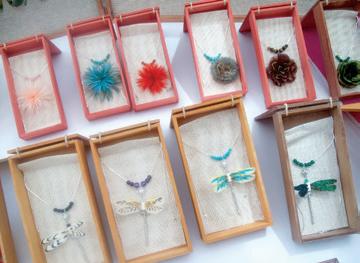
Cultural Survival Quarterly June 2024 | 29 BAZAAR ARTIST SPOTLIGHT
All
photos courtesy of Rubén Flores.
Rubén Flores in his workshop.
Jewelry made out of plumage by Arte Plumario Kozamalotl.
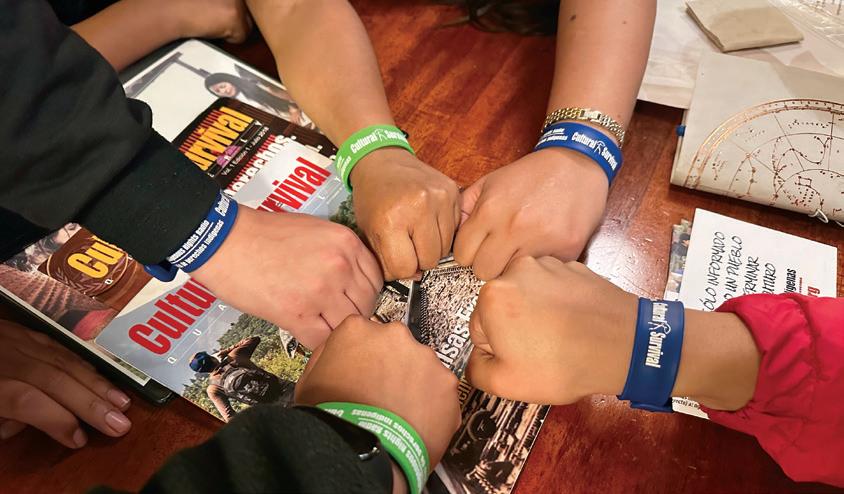
• Welcome email outlining the benefits of the Sustainers Circle program
• Exclusive invitations to webinars and Zoom conversations with Cultural Survival program staff
• Subscription to our Cultural Survival Quarterly magazine (four issues per year)
• Quarterly e-newsletter highlighting goals and initiatives you’ve helped us achieve
• Be featured on our website, sharing your story and reasons for supporting Cultural Survival
Join us in creating a future that respects and honors Indigenous Peoples’ inherent rights and dynamic cultures. Become a Sustainers Circle member today at cs.org/donate!
Donate online at cs.org/donate | Call us at 617.441.5400 JOIN OUR SUSTAINERS CIRCLE BY DONATING MONTHLY! SUSTAINERS CIRCLE MEMBER BENEFITS



















 CS Staff
CS Staff













 Fail Alsynov before he was imprisoned for his work defending Bashkir identity, language, land rights, and the environment.
Fail Alsynov before he was imprisoned for his work defending Bashkir identity, language, land rights, and the environment.


 Gerard Tiwow (MINAHASA)
Gerard Tiwow (MINAHASA)








